#Comic tips
Explore tagged Tumblr posts
Text
How I save time on backgrounds as a full-time webcomic artist
Hi! I make webcomics for a living, and I have to be able to draw a panel extremely fast to keep up with my deadlines. I draw about 50 panels a week, which gives me about 45 minutes per panel if I want any semblance of a healthy work-life balance.
Most webtoon artists save time on backgrounds by using 3d models, which works for them and is great! but personally I hate working in 3d... I went to school for it for a year and hated it so much I completely changed career paths and vowed never to do it again! So, this is how I save time without using any 3d, for those of you out there who don't like it either!
This tactic has also saved me money (3d models are expensive) and it has helped me converting my comic from scroll format into page format for print, because I have much more art to work with than what's actually in the panels. (I'll touch on this later)
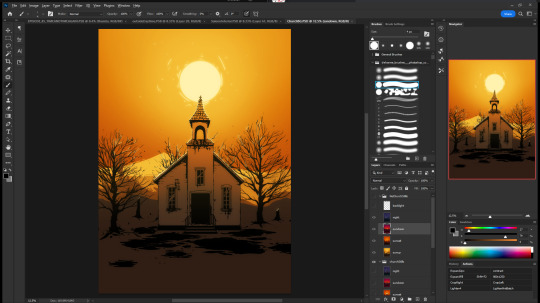

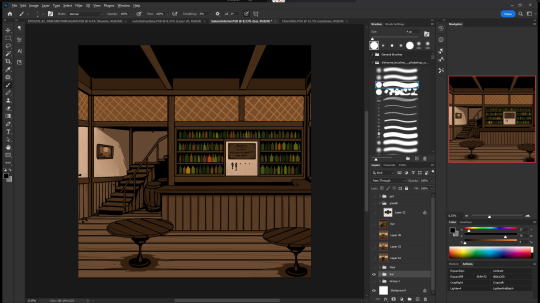
So, first, I make my backgrounds huge. my default starting size is 10,000 x 10,000 pixels. My panels are 2,500 pixels wide, so my backgrounds are 4x that, minimum. Because of this, I make them less detailed than I could or that you might expect so it doesn't look weird against my character art when I shrink portions of it down.
I personally find it much easier to add in detail than to make "removing" details look natural at smaller sizes, but you might have different preferences than I do.
I also make sure to keep all of my elements on separate layers so that I can easily remove or replace them, I can move them to simulate different camera angles more easily, and it's simple to adjust the lighting to imply different times of day.
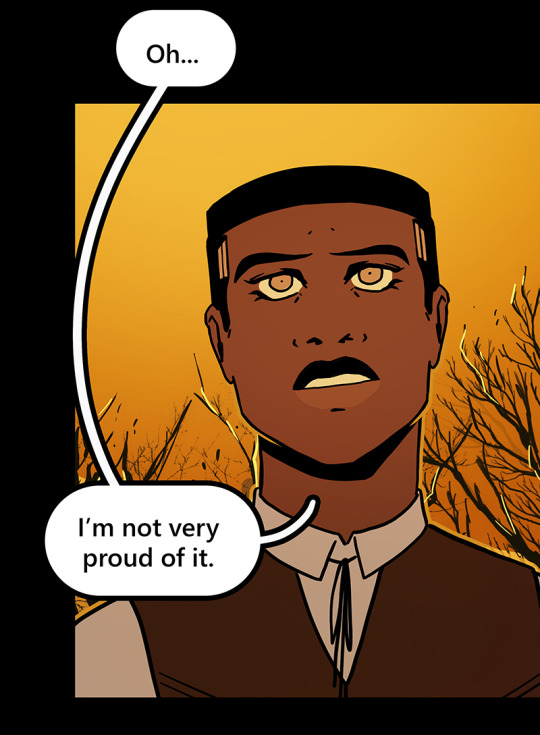

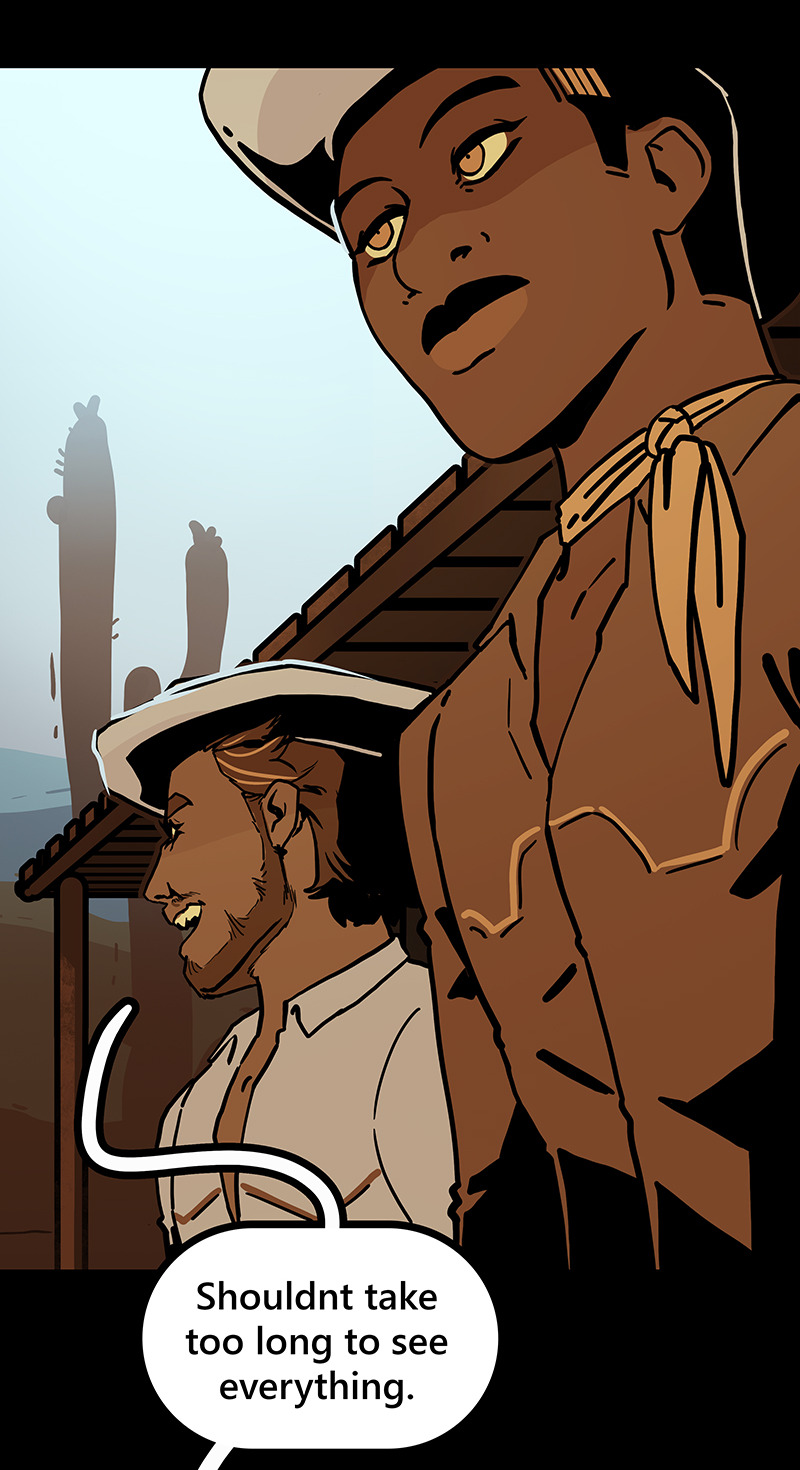
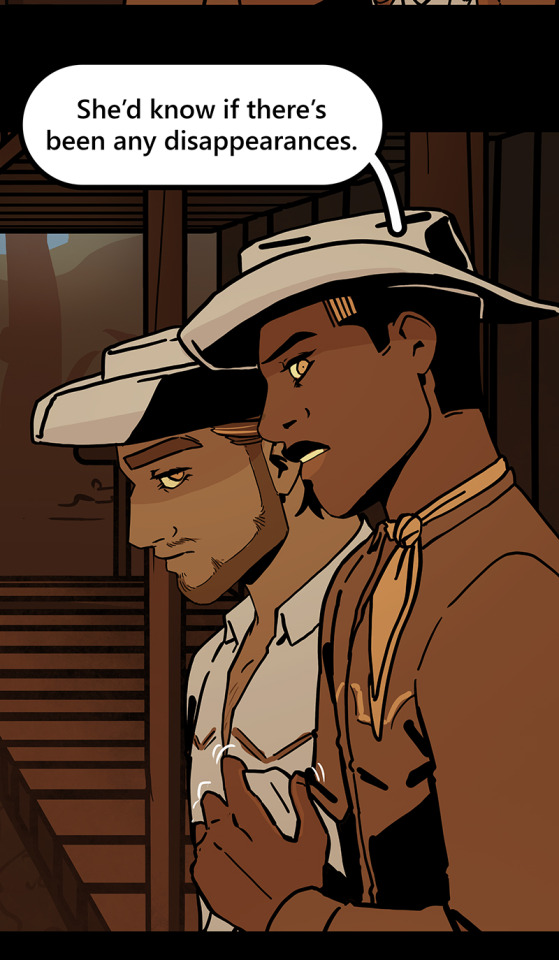

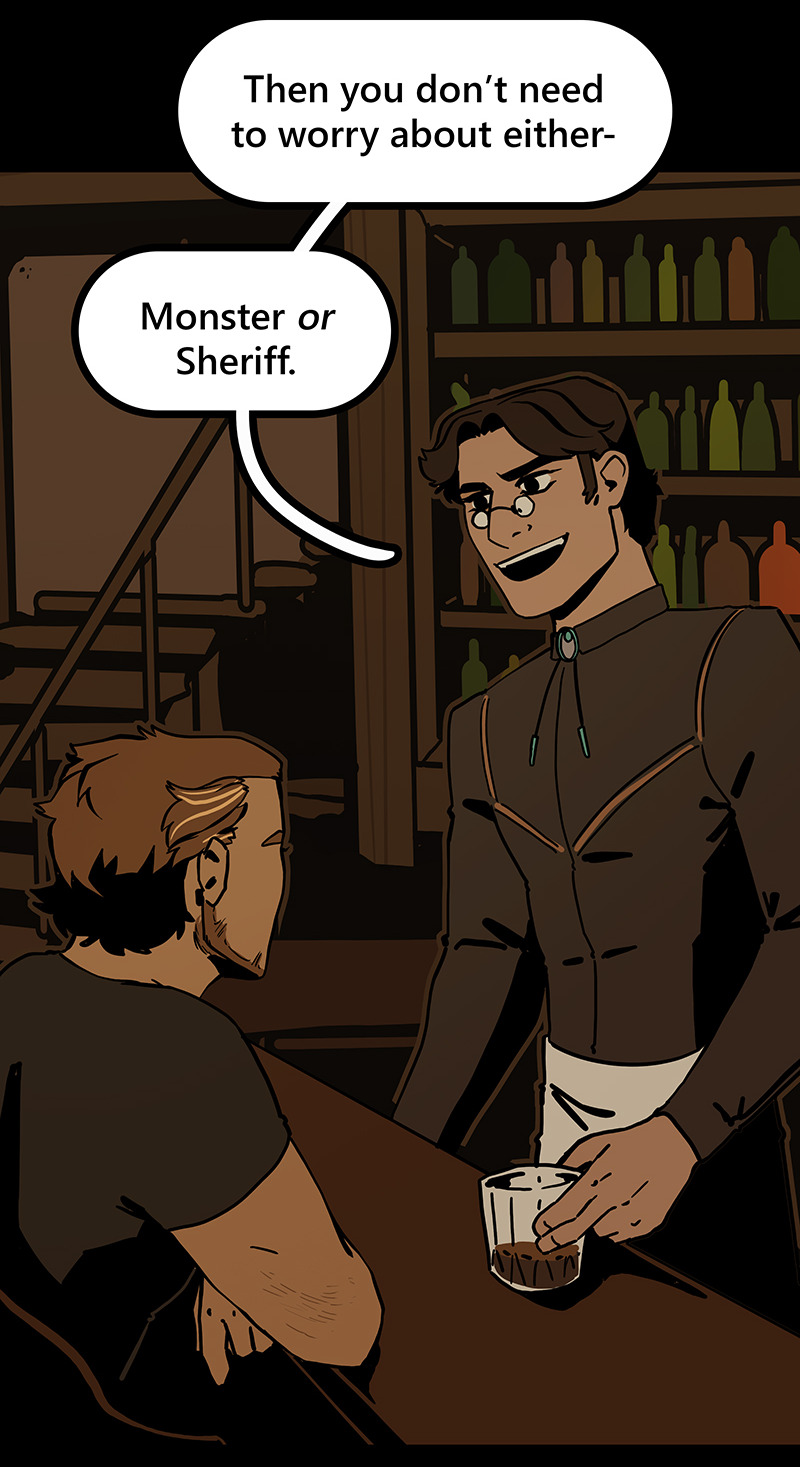
Then I can go ahead and copy/paste them into my episodes. I move the background around until it feels like it's properly fitting how I want.
Once I've done that in every panel, I'll go back through the episode and clean up anything that looks weird, and add in solid blacks (for my art style) Here's a quick before and after of what that looks like!
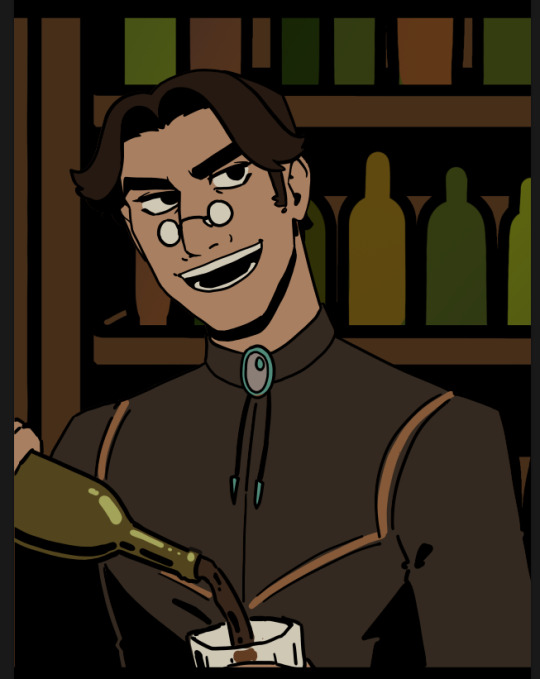
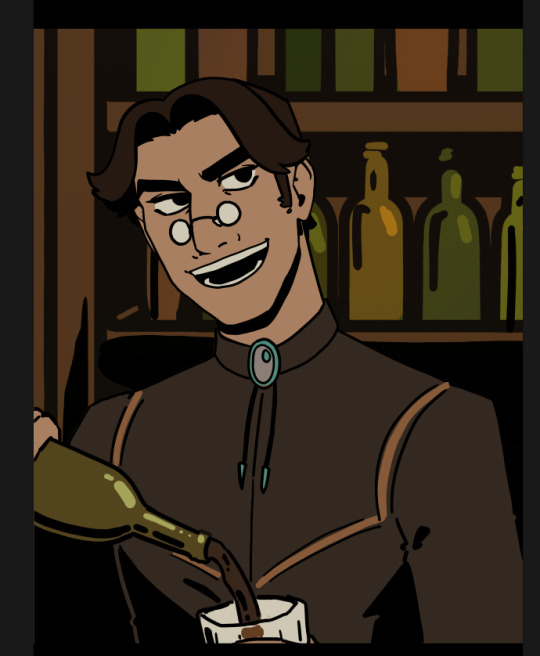
This makes 90% of my backgrounds take me just a few hours. This is my tactic when I'm working in an environment that an entire scene, or multiple scenes, will take place.
But many panels will inevitably have a location that's used exactly once, and it would waste time and effort to draw a massive background for those. So in 10% of cases, I just draw the single panel background in the episode. I save all of these, just in case I can re-use it later (this happens more often with outdoor locations, but I save them all nonetheless!)
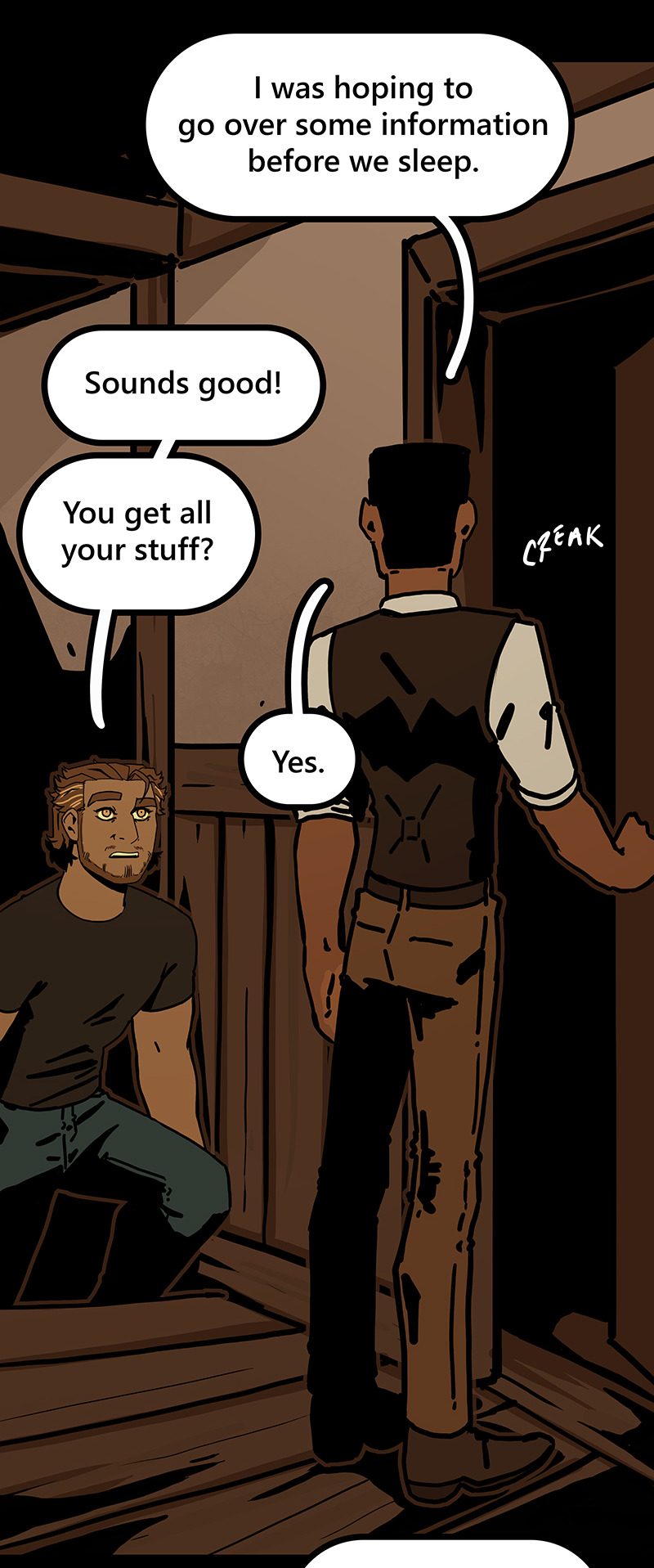
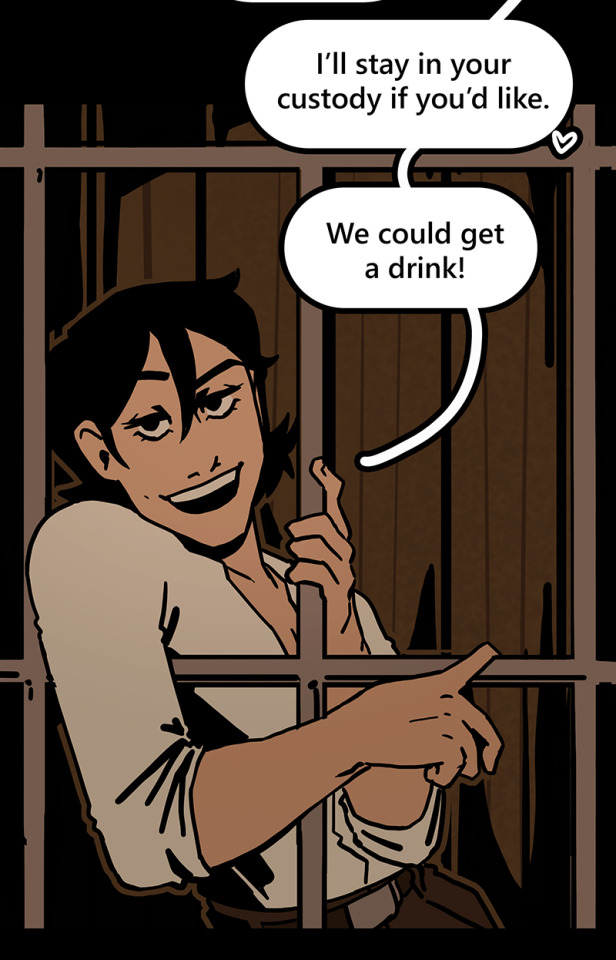
I generally have to draw about 2 big backgrounds per episode, and 3-5 single-panel backgrounds per episode! At the beginning of an arc/book the number is higher, but as the series is continuing and I'm building up an asset library of indoor and outdoor elements to re-use for the book, the number generally goes down and I save more time.
My series involves time travel and mysteries, so there's a lot of new locations in it and we're constantly moving around. If I were working on a series that was more consistent in this aspect, this process would save me even more time!
Like I said earlier, this also saves me a lot of pain and gives me a lot more options as I'm converting from scroll format to print format!
panels that look like this in scroll format...

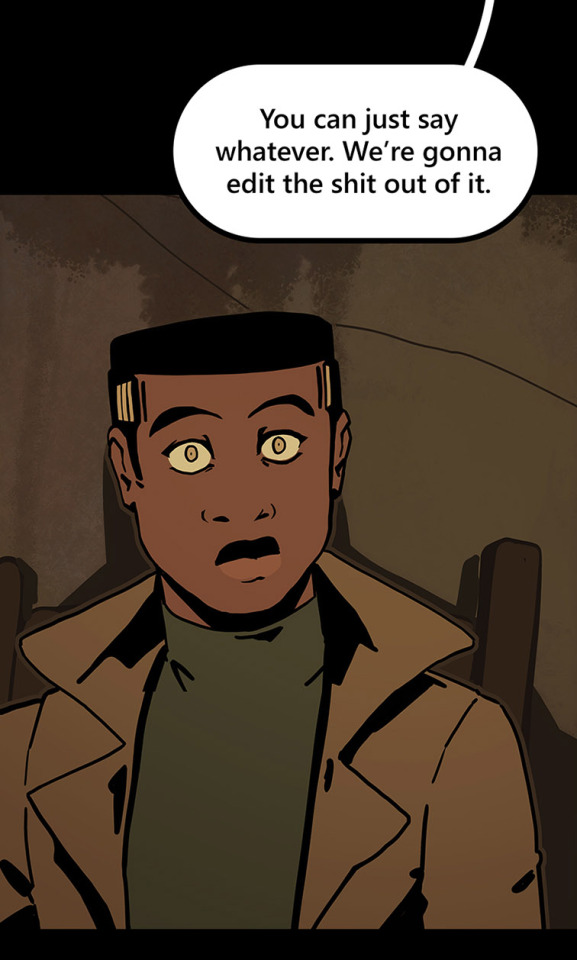
can look like this in print!

because I drew the background like this, so I didn't need to go through the additional effort to add in the extra detail to expand it outwards at all.
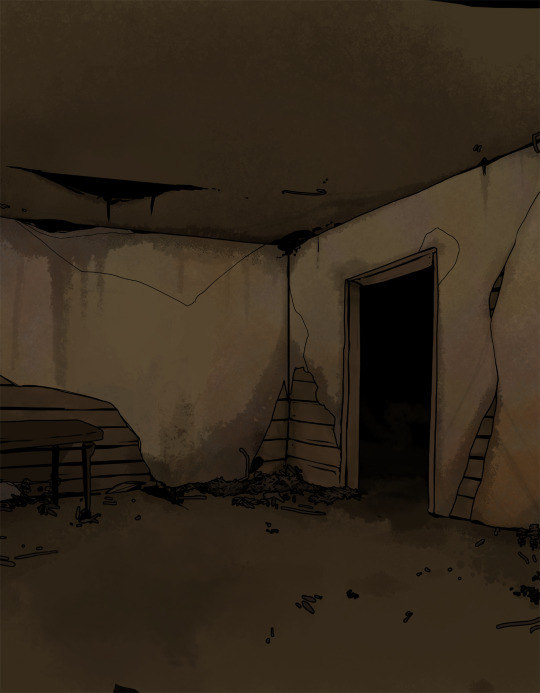
Anyways, I hope this helps someone! As always if it doesn't help, just go ahead and disregard. This is what I do and what works for me, and I feel like I only ever see time-saving tips for comics that involve 3d models and workflows, which don't work for me at all! I know there's more people like me out there, so this is for you!
Enjoy!
Also obligatory "my webcomic" if you want to see this in action or check it out!
#webcomic tips#webcomic making#comic tips#comic tutorial#art tutorial#art tips#time and time again#my ocs#digital art#ttawebcomic#hmmmm....#longpost#yeah it's a long post#I'll claim this one#lots of images#I hope this helps#I'm always worried when I make some kind of guide or tutorial people are gonna get mad at me lmao#I'm not saying 3d models are bad to use!!!#I just dont like them!#my brain doesnt work like that and it feels SO so so so tedious to me#TO ME PERSONALLY!!!#plenty of people see 3d models as a total lifesaver#and that's perfectly fine!#but yeah I don't see tutorials about saving time in comics that like... dont... mention 3d models...#like what about me and the other extremely particular girlies who hate 3d#anyways#yeah#just hoping this helps#nothing against 3d at all#I mean. ok personally yes against it cause it sucks for me to use
1K notes
·
View notes
Note
Hey what tips do you have for speech bubbles in a comic
A few, let’s see what I can come up with.
Okay number 1: If you are doing any kind of comic, DO THE TEXT BEFORE THE BUBBLE! Do not ever draw a bubble and then try to cram three long sentences into it. It doesn’t look good and the text ends up being illegibly small. Example:
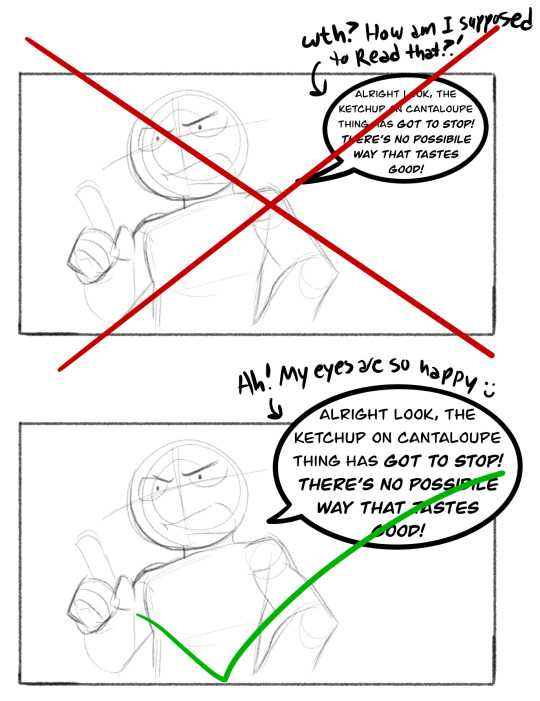
- Number 2: IT DOESN’T HAVE TO BE ONE BUBBLE! Sometimes when you’re character has a very long dialogue segment or you want there to be an audible pause, you can break their dialogue into pieces connected by tails.

This is a good tool for making sure people actually read the dialogue. A lot of people (myself included) have a subconscious reaction to big blobs of text that makes them want to skip it or just skim it. By breaking the long exposition into smaller chunks, people’s brains won’t see it as a ton of effort, and will remain focused on the story, even though it’s literally the exact same number of characters.
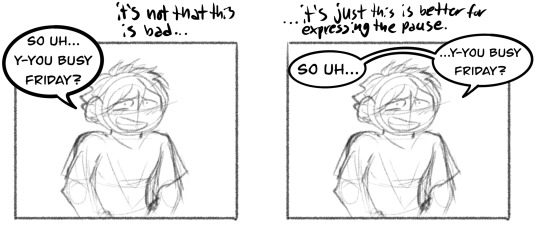
This works because of the way we perceive time in a story. Because I want this scene to feel like a slow tense moment, I split the dialogue so it takes longer for the reader to read the dialogue and thus, feel as though this moment is longer.
Number 3: PLAN FOR YOUR SPEECH BUBBLES! This is something I have had to learn the hard way! Do not draw the picture and add the speech bubbles later. The way you draw a picture without speech bubbles and with is very different. Example:
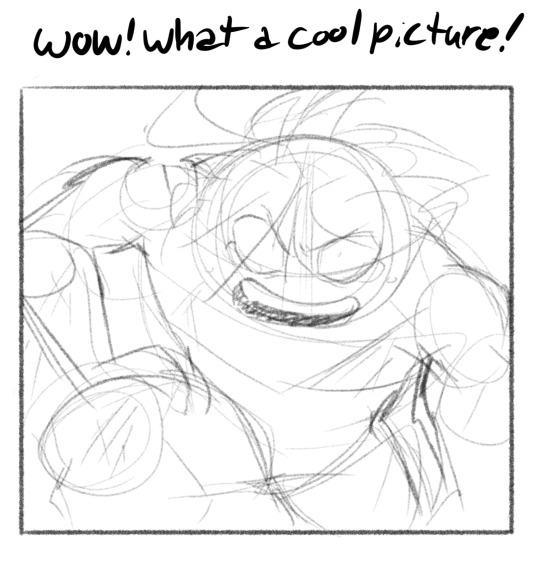
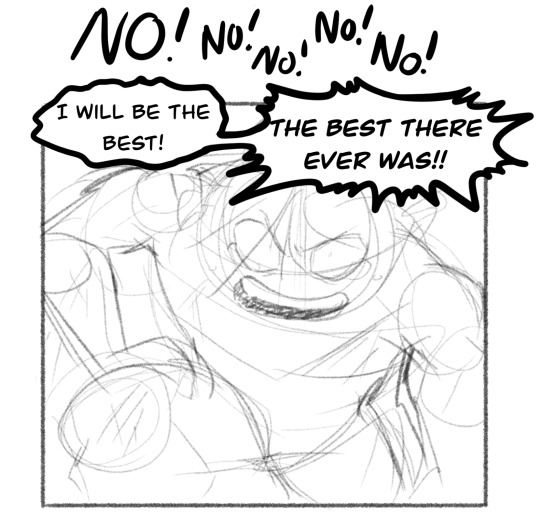
This is not good! The speech bubble is cutting out your picture! Now, everyone does their speech bubble differently, I do mine at 90% opacity, some don’t do any bubble and just draw the speaker’s tail, but many do 100% opaque speech bubbles and this is not good! How to fix it:

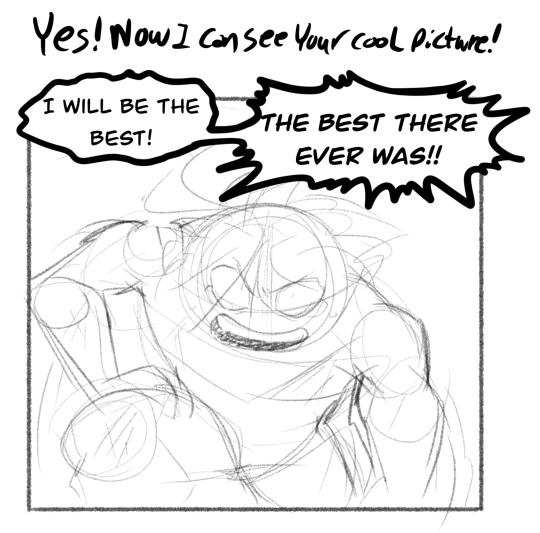
Plan where your speech bubbles will go and purposely leave empty space there or something that you don’t care about as much, like the tips of their hair, or their bandana tails, or the end of their scarf, etc. Just make sure that your image is small enough that you can still see it with the speech bubbles on top. If you can’t shrink the image enough to fit it and the speech bubbles, then you need to consult rule 2.
Alright, I think that’s it! As a recap: Do the text before the bubble, The text doesn’t have to be in one bubble, and plan for your speech bubbles!
Hopefully you found this helpful, if you have any further questions, I’d be happy to help!
Good question! :]
821 notes
·
View notes
Note
Your comics are so beautiful!! Could you give me a tip?? I'm a beginner

Giving comic tips is a bit hard because theres so many tips to give! (And i'm still learning myself).
Something I've learned before even starting a comic making, was learning to decode other comics I enjoy. Learn why I like them. The page format, page lining, dialogue boxes, character designs, and story development are things to look at and understand. Try and replicate the things you like (and things that are reasonably achievable of course).
Treat each page as it's own mini cliffhanger. You want the momentum to flow through the comic. Keep your audience on their toes! What's going to happen next!? OH MY G-
See! I got you to click the keep reading! Yay!
I hope these helped at least a little <3
185 notes
·
View notes
Note
Yo yo I got a question!
What does your process/workflow for creating comics look like? I’ve dabbled in making some myself but could never really get it right…especially the script. So what does yours look like? Any tips for laying out the panels and keeping people engaged with the story?
Howdy! I've broken down my process in this ask right here but I'll see what I can say say about paneling specifically that I didn't already say in there!
Hmm, well, I can certainly say that your biggest priority when setting up a layout for your panels is to make sure everything flows correctly. Make sure your eyes NATURALLY feel drawn to the correct next panel when you're going through it.
Here's an example of what not to do:
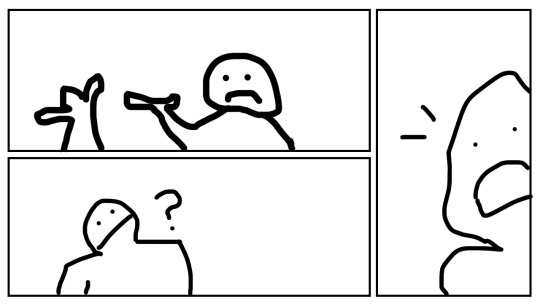
(Forgive me, I put this together super fast with a trackpad in photopea)
See, the thing about this, and why it sucks, is that your eyes don't know where to go next after that first panel. We (westerners at least) prioritize reading left-to-right, then go for up-to-down -- However, this creates a strange zig-zag for our eyes to follow. The flows all fucky wucky! No good! Clarity is the name of the game here, so keep yourself absolutely 100% aware of how easy it may be to figure out where to go next on a page. Now, that said:
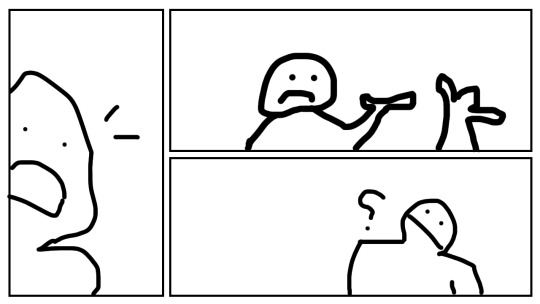
This is literally just the same image flipped, but do you see how much easier it is to figure out where to go next? Left-to-right, and then up-to-down. EASY!
A final piece of advice (that I may have given before but I've forgotten) has nothing to do with paneling, but does have everything to do with scripting. This SERIOUSLY depends on if you're making a webcomic or comic or graphic novel, like do NOT do this unless you're doing a webcomic, but If you can get away with ending a page on either a joke or a cliffhanger, do it. You WILL keep people from forgetting about the story and moving on. Make sure they need to see what's coming next OR give em a good enough laugh to stick your comic in their heads for a while.
Really though, the true trick to keeping people engaged with your story is consistency. Have a schedule and stick with it (I'm bad at this but at least I post ONLY on Thursdays now and try to not take more than two weeks on a page). If people have to keep guessing when your next upload happens, they're going to lose interest fast. Give your readers a fair enough chance to stay engaged by being reliable -- And if you do end up slipping up with your scheduling, do be sure to tell people when you'll be back.
It's absolutely your project, so you set your own schedule! But people get busy, so absolutely keep that in mind!
That's all I can think of at the moment! I hope this was helpful to you!
56 notes
·
View notes
Text
I have learned how much more easier and better it is to plan shots in panels by laying out the area your characters are in, because like, you KNOW where shit is
Just do like, a simple floorplan of the area, at the very least, and it helps a million, I swear
Like this, doesn't have to be as in depth but it helps fr
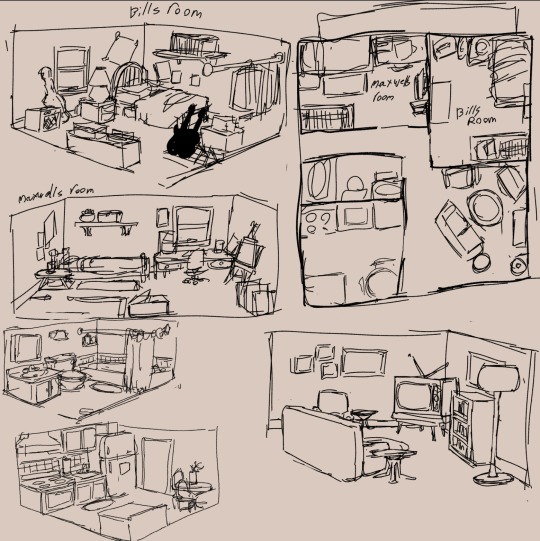
#art#drawing#artists on tumblr#small artist#artist#my art#web comic#comic art#comic artist#art advice#drawing advice#art tutorial#art tips#drawing techniques#drawing tips#drawing tutorial#comic tips
213 notes
·
View notes
Note
how to make. comic
Step one after coming up with a really epic idea (aka daydreaming for hours on end) write it down and doodle it really shitily in your notes
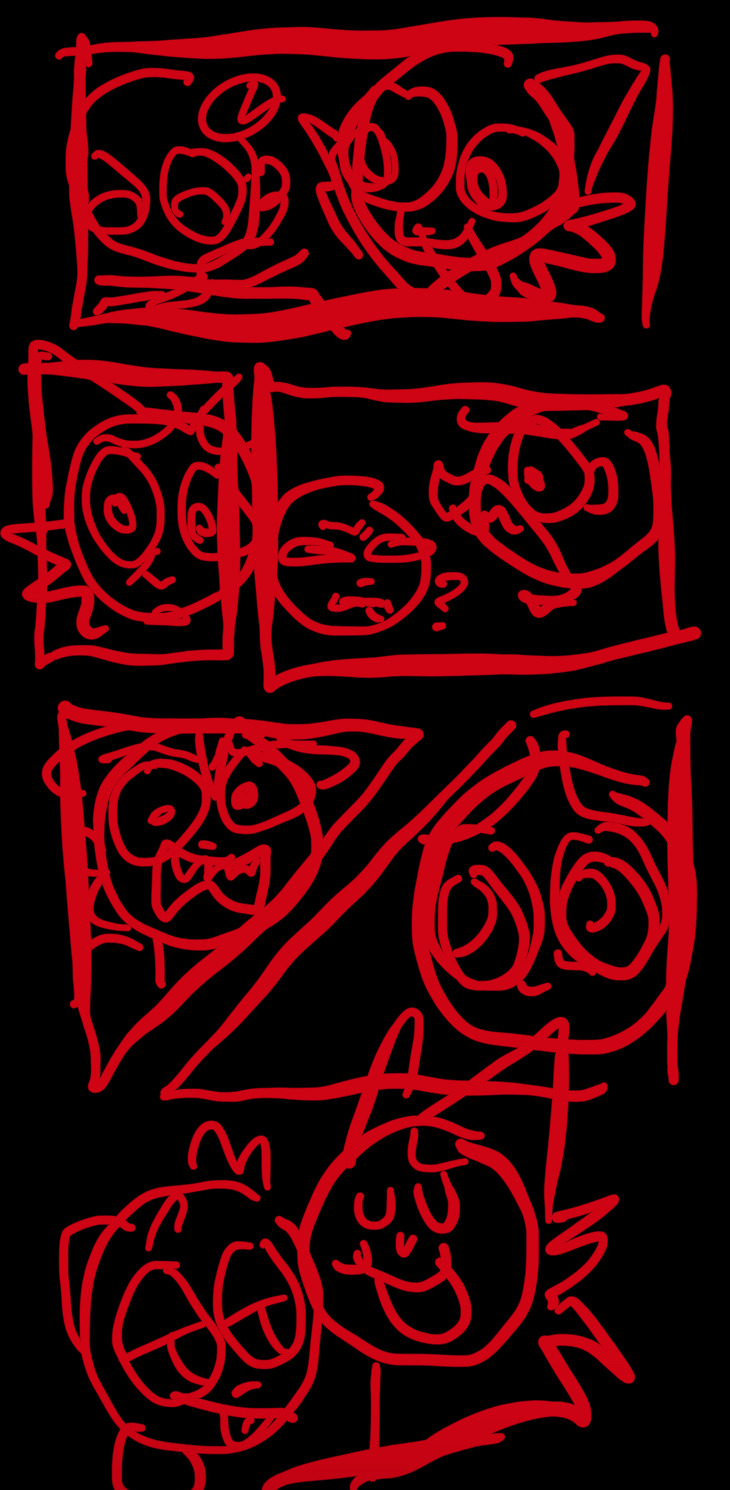
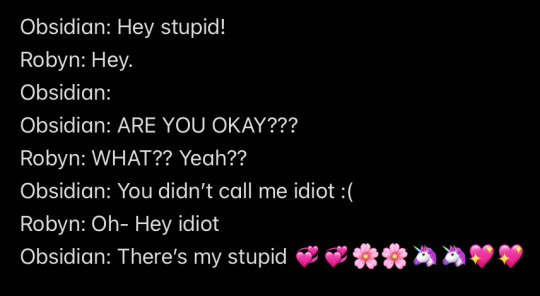
Step two forget about it for months on end before making it (I have so many random comic ideas unfinished) (this is why you write it down before hand)
Step three finally get your ass up and make the sketch 💞💞 Step four spend way too much time making the panels because they HAVE to be perfect for some reason (or else I’ll freak tf out and die /j)
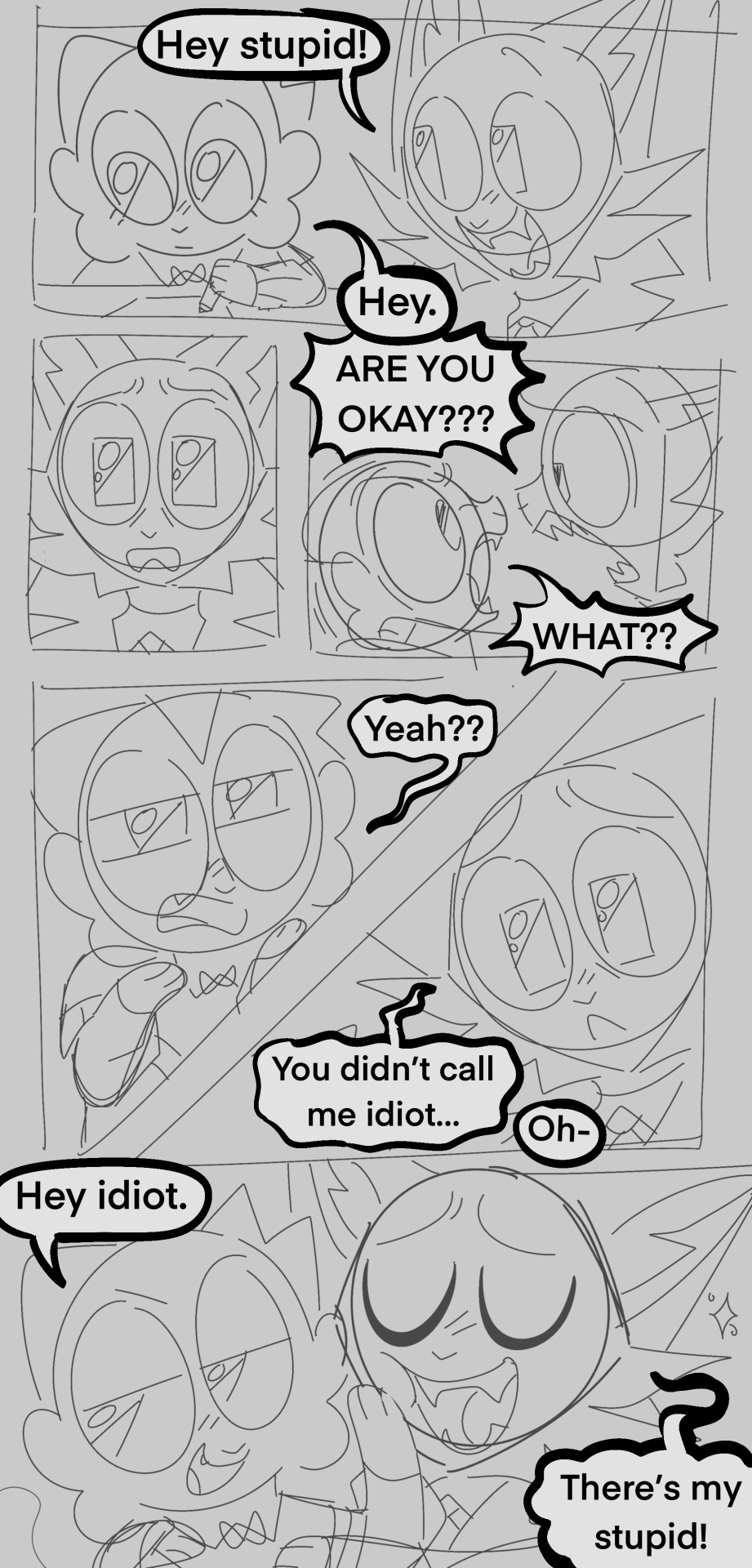
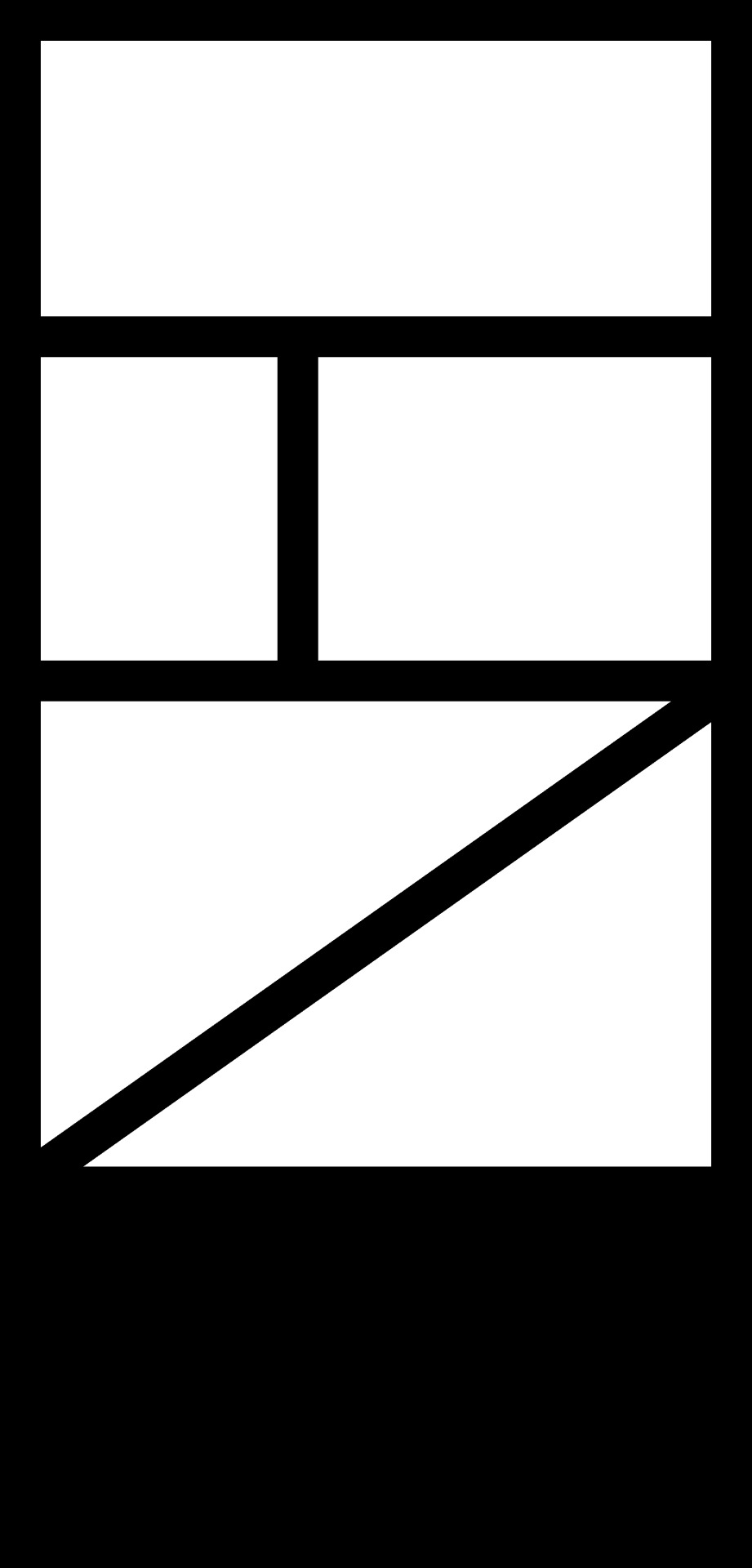
Step five and six make the lineart and coloring, and then add the speech bubbles, this is where you can tweak the wording and or change where the speech bubbles go (mostly done so it flows better)
(Don’t be afraid to cover up your art with speech bubbles if needed, ik it kind of sucks but reading ability is very important in comics, and having your speech bubbles all wonky WILL turn off readers, no matter how good your art is)
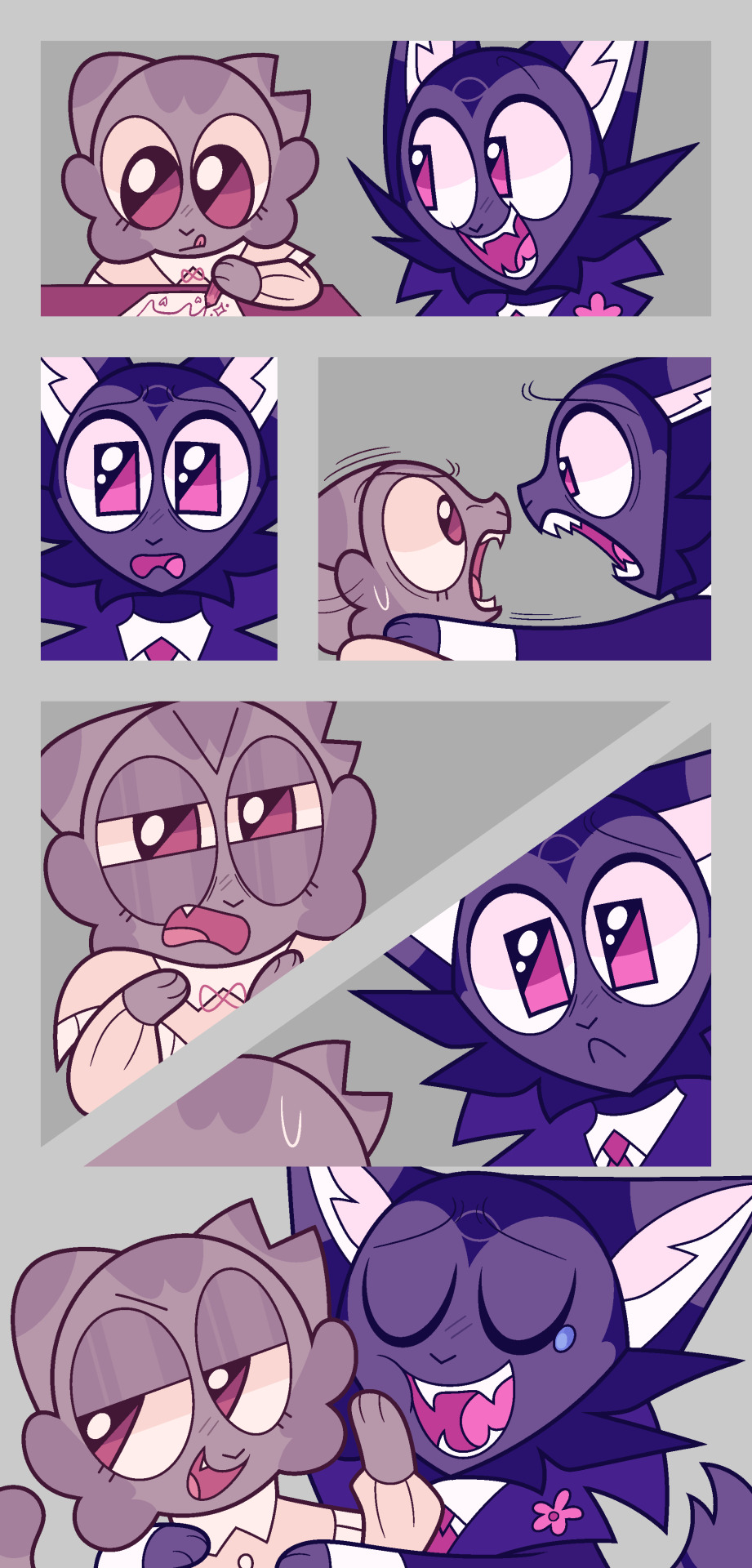
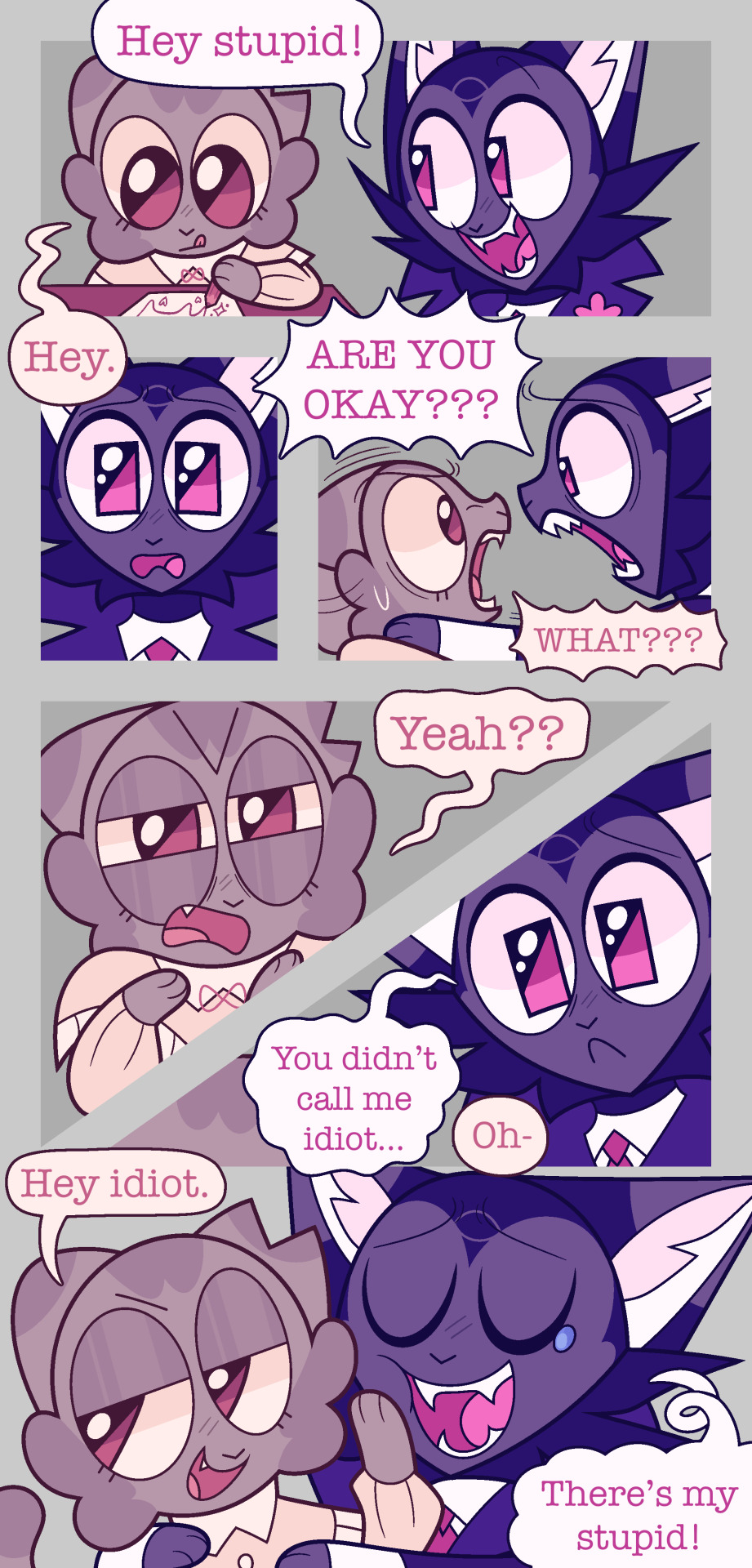
step seven make a REALLY lazy background because you do NOT want to do shit this time!! (Pretend they don’t have lighting on them I merged the layers 💖)
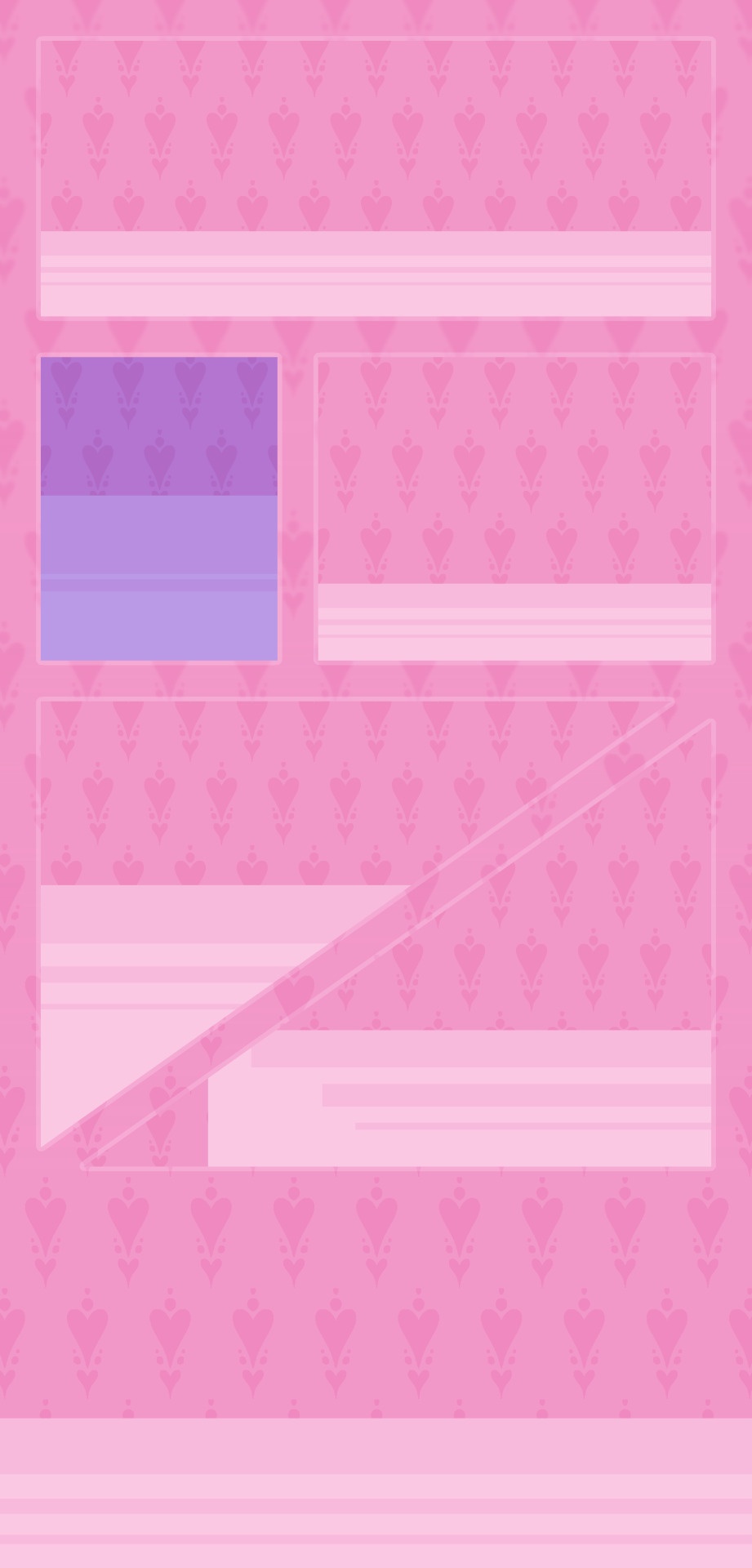
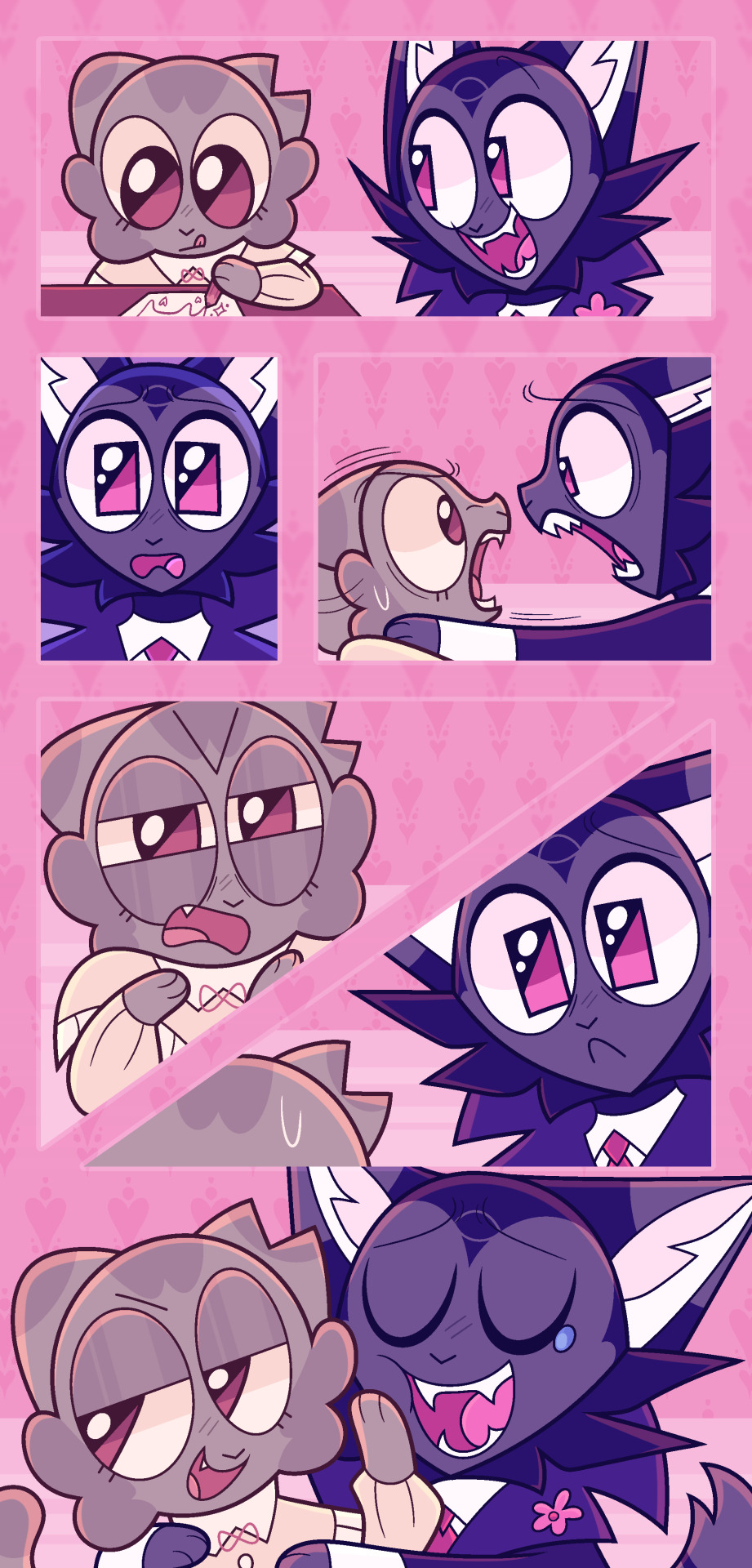
Step eight spend too long on rendering aka lighting and shading!! Step nine add more epic effects aka final touches!! This is always nice to do because it makes it look a lot prettier (like adding overlays, gradient maps, blurs, and noise… idk)
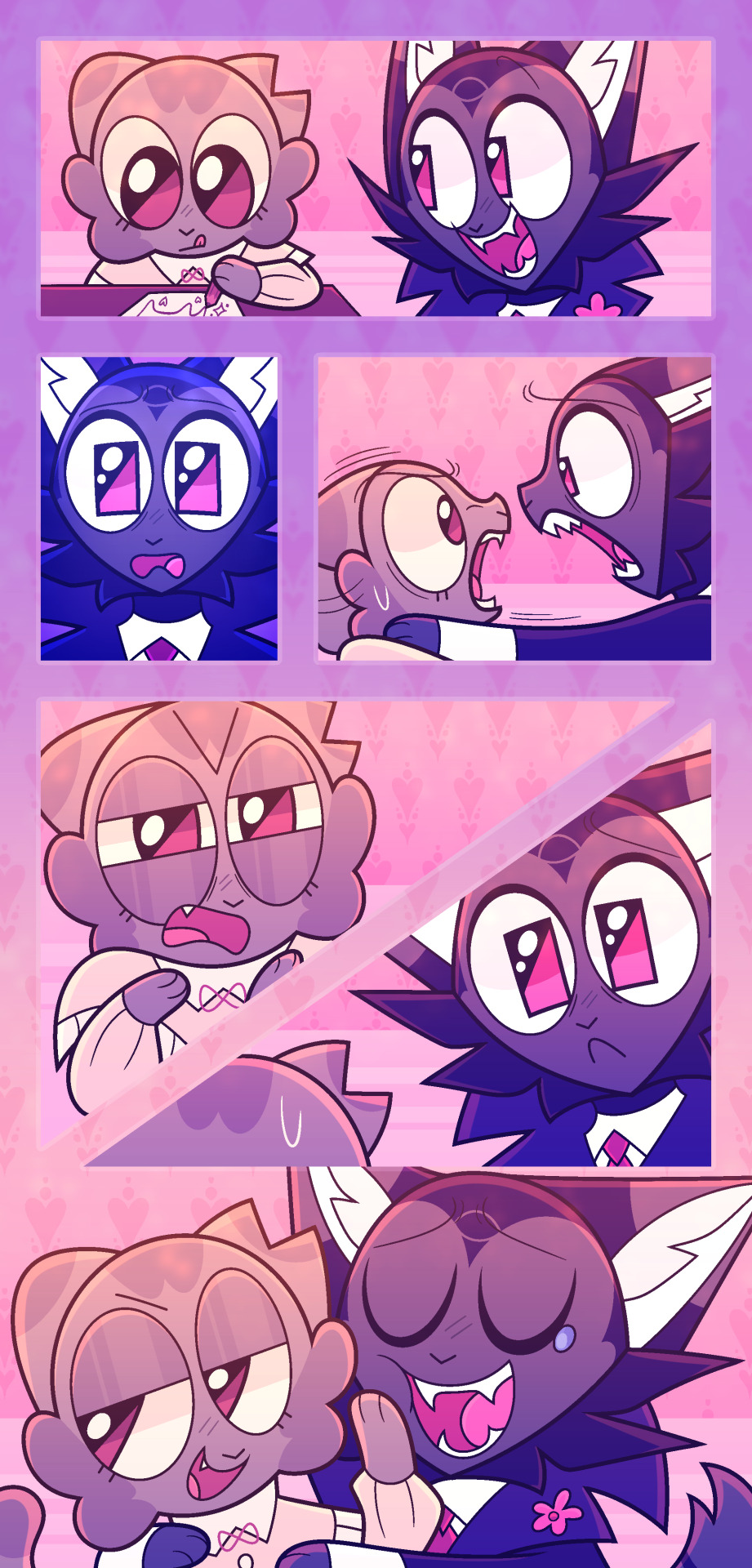
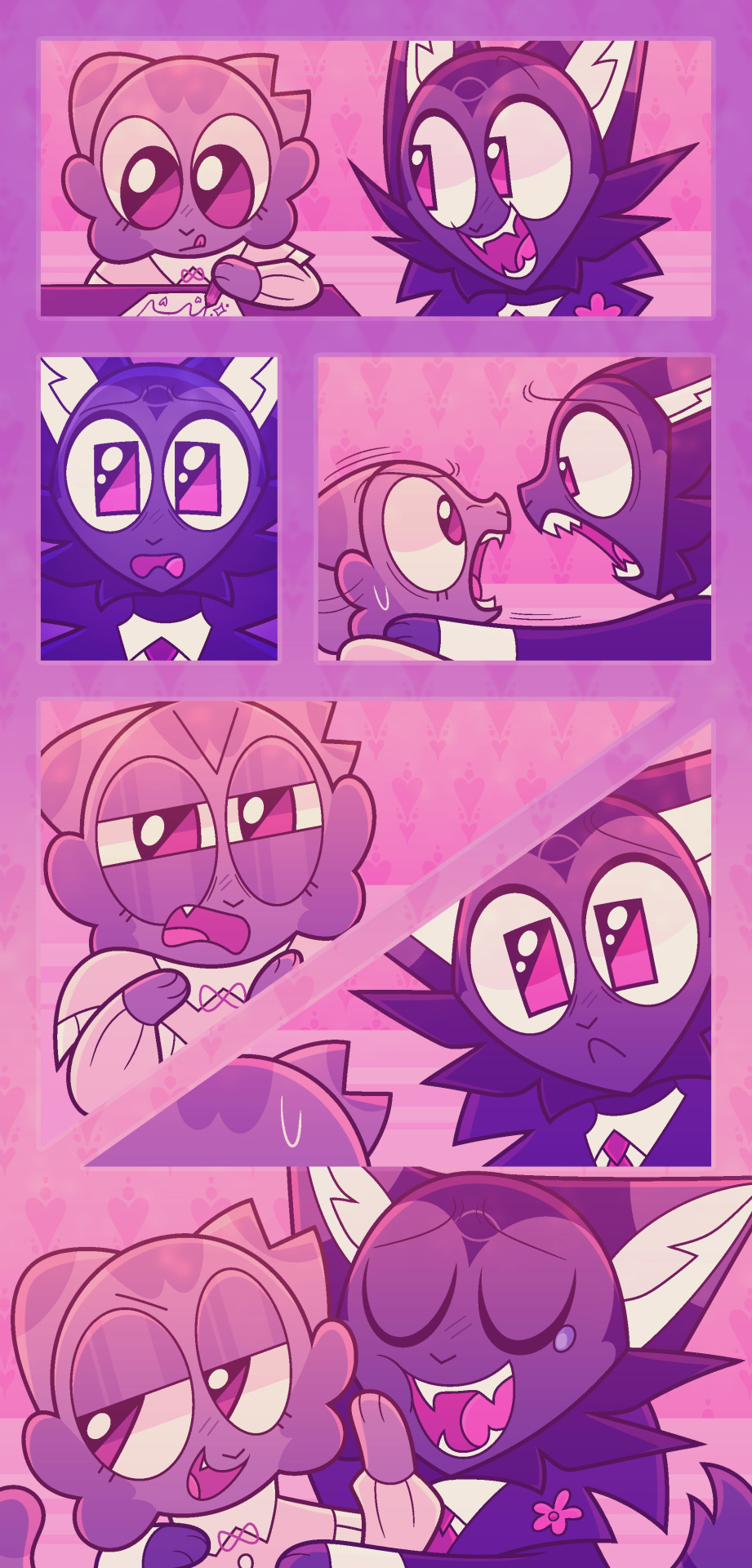
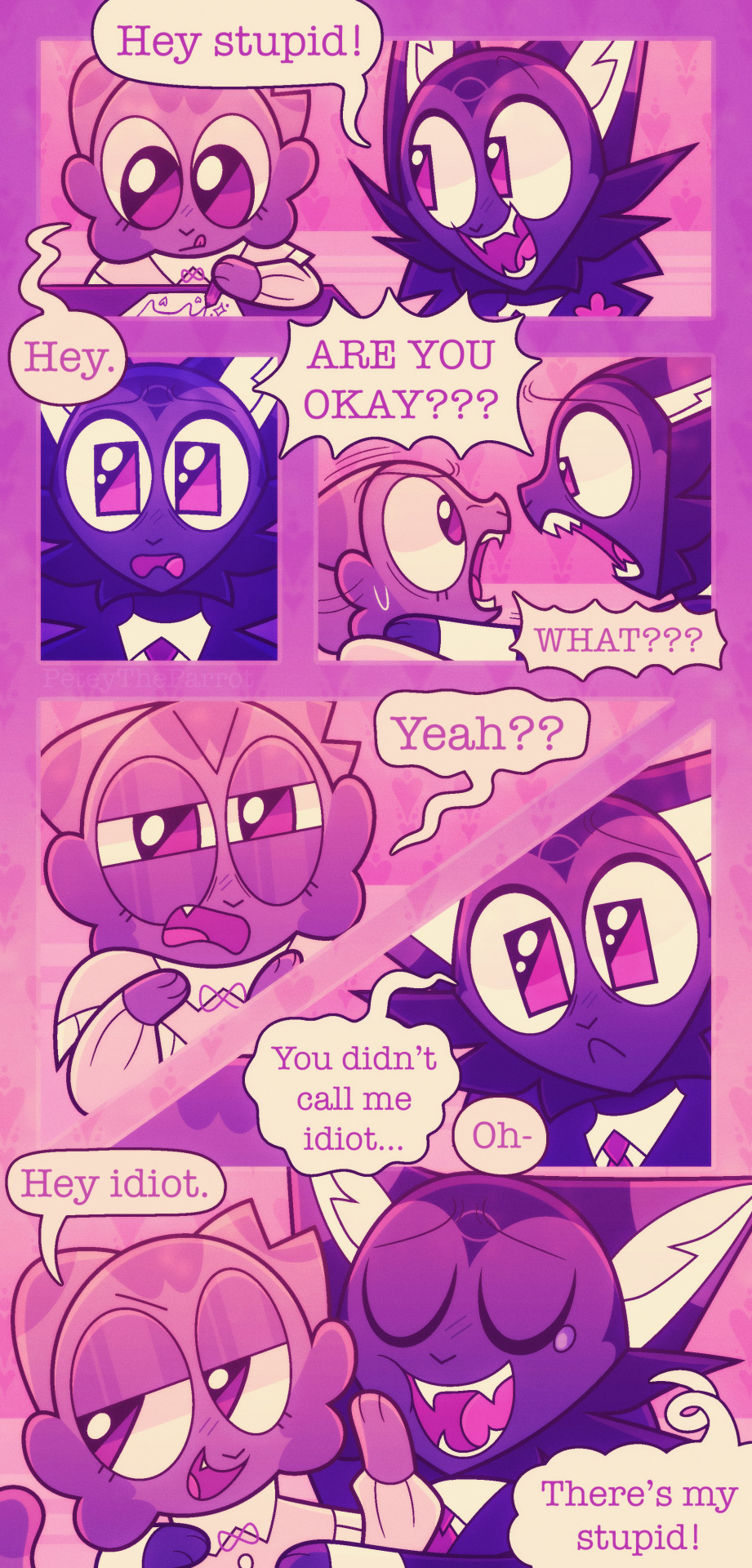
Andddd you’re done, I usually work on multiple comics at once because I CANNOT sit on one thing only!! Nuh uh!! Comics take fucking ages and will ALWAYS take ages so if you don’t have the patience for it I’m sorry bro 💔 you will not handle it 💔
Although! When I started making mini comics they took me like? 10+ hours but the more I did them they now take around 3 hours at the shortest. This one took 5 hours.
This is just how I make comics btw, most comics I see don’t go fucking crazy on the rendering/lighting/shading (usually on comics I see there is none tbh! And it works for them!) I’m just insane and like to make my comics look really pretty or else I’ll explode for some reason.
Also 😇 if you wanna see more comics of these guys go here for places you can read them at 😇
#Asks#myart#sorry I took so long to answer this anon (this ask is from November whoopsies 💗 I take ages to answer things but I’ll get to them#eventually lol)#UHHHH IDK IF THIS WAS HELPFUL I DONT REALLY HAVE?? THAT CRAZY OF A PROGRESS I JUST#WRITE DOWN IDEAS AND THEN DECIDE TO TURN THEM INTO COMCIS IF I HAVE THE TIME LMAO#comic#comics#comic tips#tips#tip#art tip#art tips#comic tip#comic strip
48 notes
·
View notes
Text
working on a mini comic based off of lyrics from 'this is the best day ever' uhhhh...
does anyone have tips on how to like make comics.
or does anyone have procreate brush packs that are free :0 i'm in need....
#mcr#fanart#my chemical romance#art#mcr fanart#gerard way fanart#gerard way#my chem#this is the best day ever#ibymbybmyl#i brought you my bullets you brought me your love#bullets era mcr#bullets mcr#comic help#comics#mini comic#art help#art tips#comic tips#digital art#help me pls#idk how to make comics
27 notes
·
View notes
Text
youtube
23 notes
·
View notes
Text
Tip for Comic Artists+Writers
(If you don't do this already!)
Draw in ballpoint pen. In a notebook.
If you're like me and you struggle to plan your script in a word processor, or you struggle to "storyboard" or even sketch in a digital art program for your comic...
Don't do that part! At least, not yet anyway!
Scribble and sketch and doodle your characters, and their lines of dialogue, wherever you want on a piece of notebook paper, with a ballpoint ink pen. You can try and figure out the comic panel configuration of a page if you want to do that, but otherwise I recommend you don't do any panel-planning yet... in order to not limit yourself to a single page in the story. Draw the first and last scene in the same page, or only draw the witty one lines you had in your head that made you want to make this comic!
The benefit: there's no pressure to get it perfect!
Don't like how you drew the hands? Well scribble it out, or ignore it; it's not the final draft by any means. You're just getting the idea on paper so you can visualize it! It's the best way to practice what emotions you're trying to convey, or the positions of the characters, without worrying about if it's "good" or not. It gives you the freedom to make mistakes, so you aren't paralyzed by the possibility of making those mistakes and the trouble of having to edit them.
You can use a sketchbook or a pencil, but for me, this defeats the purpose of letting myself experiment and make mistakes with the art/dialogue. You get visual representation of what you want to work on (scribbled out hands tells me, "be sure to practice hands and gestures!"; Stricken out dialogue lines tells me, "yep that's not how I want him to say it. Maybe I should practice a few different variations of that line?")
Their faces can look wonky, their word bubbles can be poorly placed, and the dialogue can be absolute "cringe"... and guess what? It doesn't matter because first of all, it's hilarious what you can come up with when you let loose, but second and most importantly, you're getting your ideas down in writing and on paper!!!
--additional note: it gives you so much for you to reference from as well. I recommend letting the notebook be your central spot for experiments, concepts, story ideas, notes, reminders, and important details for your story/comic/graphic novel so it becomes a personal reference guide for you (and maybe somewhat of an encyclopaedia?) :)
I hope this is helpful - it has been for me!
#i had this posted privately but never shared it#but guess what it works SO WELL for me!!#so i'm sharing this for anyone who may benefit from it!#this totally helps me overcome writers/art block#it's just about foolproof!#my post#hope this works for somebody else!#graphic novel#comic tips#writing tips#comic development#comics#art tips#creative#comic writing#story development#comic writer#comic artist#graphic novelist#graphic novel tips
40 notes
·
View notes
Note
ive really been loving the pacing of your story and i enjoy the concept and the bits that have been released about the plot! youre doing really well, and i admire it greatly!!
ive been having trouble figuring out an overall plot in my own work, i just have character ideas and the vaguest idea for a storyline. i try to just write but then i usually end up taking a break (re: dumping it) because i don't have anymore ideas for how to complete the plot. i've laso been curious about how you go about writing for a comic (do you write then do thumbnails? do thumbnails then go back to figure out dialogue? a third thing?) so i was wondering if you had any advice or resource tips for writing? both for comics and for overarching plots, if that's okay
if you don't have any ideas tho, no worries. i was just curious. good luck with Felt World! i love everything that's coming out so far, thank you for gifting us it!!
Oh thank you so much!! I can't say I'm a comic book artist at heart because I really don't have much experience, I was only an illustrator for a short while and never wrote anything myself, but learning from past mistakes (i.e. I don't stick to plans), I've so far done this and it seems to work:
I'm one of those that don't like to plan strict layouts for the entire thing, because chances are I will not stick to it, so what I've done for felt world is just write a sketch for the overarching plot, the b-plot and c-plot, with rough estimates in what order I want the major plot points and settings to be. My current sketch looks like this;

(which is done in Miro) and as you can see there aren't that many plot points, because I want to have the wiggle room to come up with something on the spot. And also, my comic focuses a lot on interpersonal relationships, character development, and themes rather than the plot, which means it needs to be concise or else the comic is gonna take 6 million years to finish.
And now,, I think this might just be how I work, but I think it's easier to be creative when you have strict restrictions rather than all the choices in the world.
for me, personally, I restrict an update of 10 pages tops, because instagram only allows max 10 images per post! This means I have to 1) fit all I want to say in 10 pages, 2) it has to be concise or else I infodump on readers, and 3) I have to answer some sort of question within the update, or else I said nothing and I start over.
As for scripts, I tend to write one or two sentences of what's going to happen for the update, and then I get to thumb-nailing and sketching right away! I come up with most of the dialogue on the spot too.
And also, I think what's most important, is that you take your damn time! If you aren't immersing yourself in your own world, how do you expect your readers to do the same?
I'm very much a believer that the stories you are telling are something that comes to you naturally if you just sit with it and listen rather than demand that it makes itself known to you. When I brainstorm for felt world I quite literally sit in my bed and go "omg!! And then what? :0" TO MYSELF LMAO as if I'm not making everything up myself! I think that's extremely important that your story is engaging to you first and foremost!
And as for more practical tips
carry a notebook with you or use your notes app AS SOON as you get ideas to write them down! No you will not remember, lol.
set rules of what you're not allowed to do with your story so that you don't fall into lazy trope territory! You can do that when you brain storm, but finesse the story post brainstorm to just make it.. smarter.. if that makes sens For example, don't kill your gay characters, don't make sensitive men the butt of the joke, don't make your women fight over men (unless it's the point), etc.
set physical restrictions! For example, max amount of pages per upload, max amount of pages for the whole story, max amount of characters, etc.! That literally forces you to problem solve, which by definition is creativity! Like, oh you can't do this the obvious way? Do it the creative way! That's way more fun!
I could probably go on, but this is too long already! But I hope it at least helped somewhat!
42 notes
·
View notes
Note
if i may ask, is it difficult at all to re-edit/organize the comic pages from the webtoon format to fit the graphic novel format?
on another note, I'm so happy that your kickstarter was funded!!! I love time and time again, im so excited to see this all happen <3
I'll just turn this ask into something of a guide for the process! Because yes, it is difficult, but there are also many ways I have been preparing from the beginning for this very situation to make things easier for me!
I've worked in both print and scroll in the past, and have done this transition once before for a short story, so I already had familiarity both with my goals for print, and struggles with the transition!
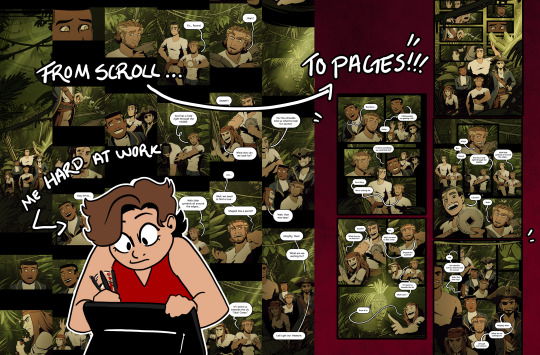
How I prepared from the beginning for this transition:
1: My panels are 2500 pixels wide, so they can span my page (which is 8.3x5.8 inches) at 350 DPI (which is print quality)
2: My layers are organized: Text, FX, Foreground, Characters, Background
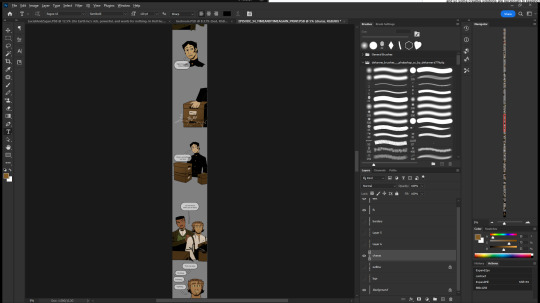
3: I draw one very large (twice as big as any panel would be, minimum) background for my major locations, as well as drawing furniture assets in isolation. This not only saves me time when making my actual episodes, but it also offers me INCREDIBLE flexibility when making this transition to print.
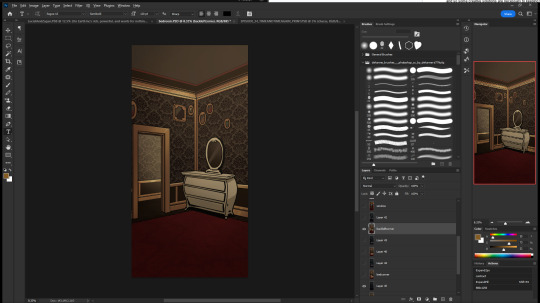
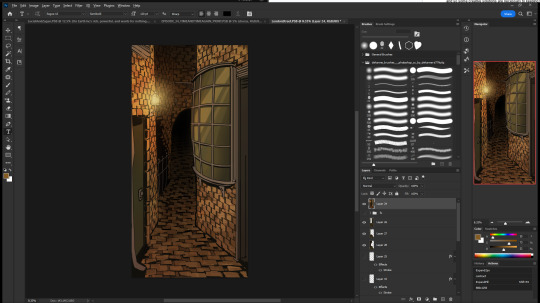

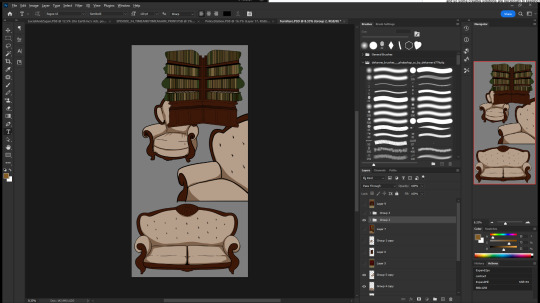
These 3 things let me pull the character art to the page by itself, scale it up or down to fit my panel, and then fill in the background behind the character.
So, I read the scroll version, decide how many and which panels I want on the page for the pacing (I also keep page spreads and page turns in mind while I am doing this), and then I pull those panels over from the scroll version to the page.
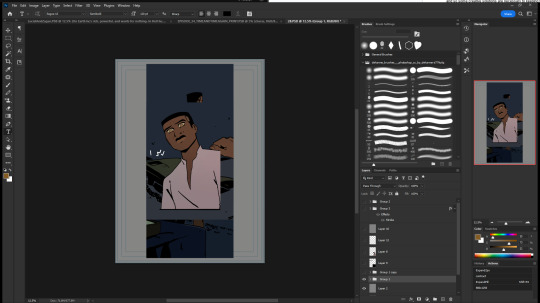
Then, I make the panel borders/page layout that I want, fit the character art into it, paste in the backgrounds, do any art editing that I need, add FX, and then re-do the text!
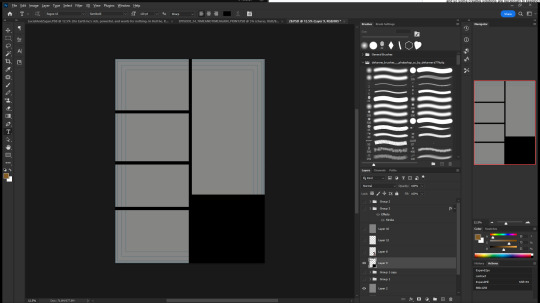
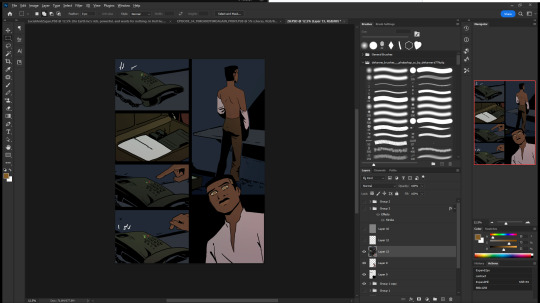
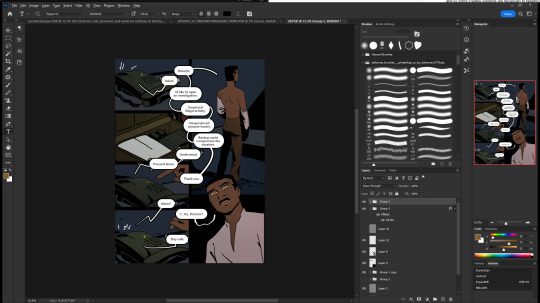
Sometimes I do need to draw parts that are missing (shoulders or elbows getting cut off is an extremely common one) and sometimes I need to adjust facial expressions, cut panels, or rearrange panels to make things read more clearly. Since it's my comic already, I know how to do these things while maintaining the original intent, but if I were working with someone else's comic I would need to work closely with them to know what can and can't be cut.
(original panel vs an expanded version)
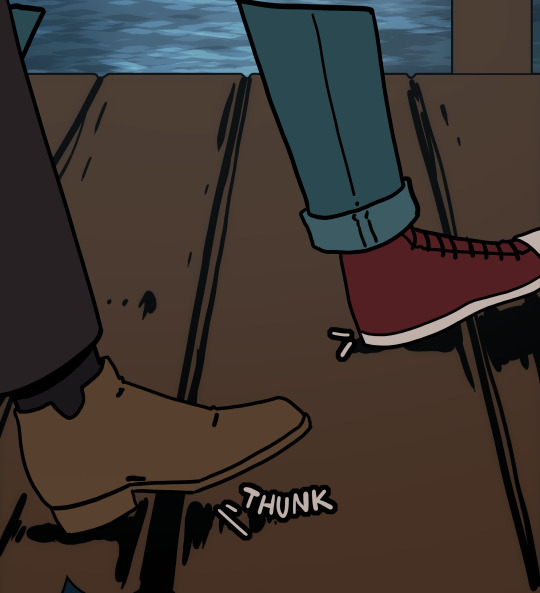
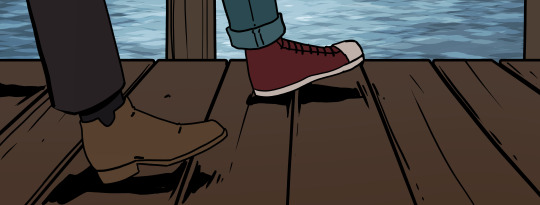
Another common issue is that VERY tall panels will inevitably lose a lot of information when they’re turned to pages. Identify the purpose of the panel (pacing, showing a lot of detail, etc) and then replicate that with your page layout.
examples (in order) are: scene transition, being overwhelmed, suspense, and establishing shot. All of these were a single panel in the scroll version!

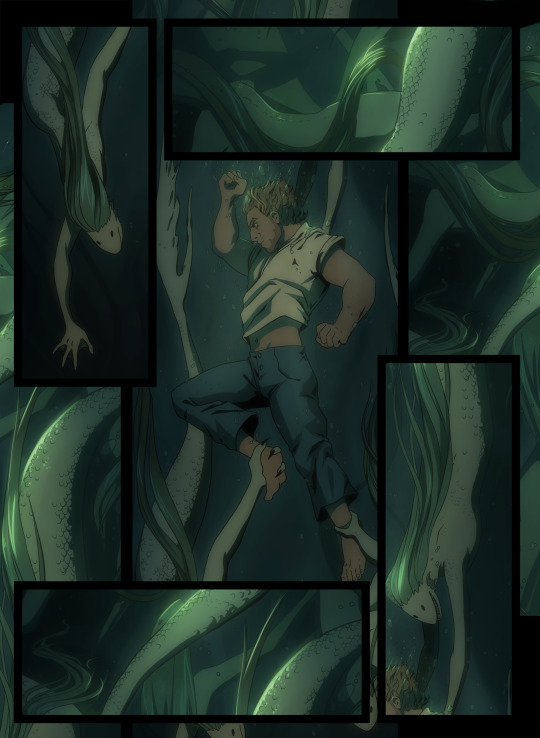
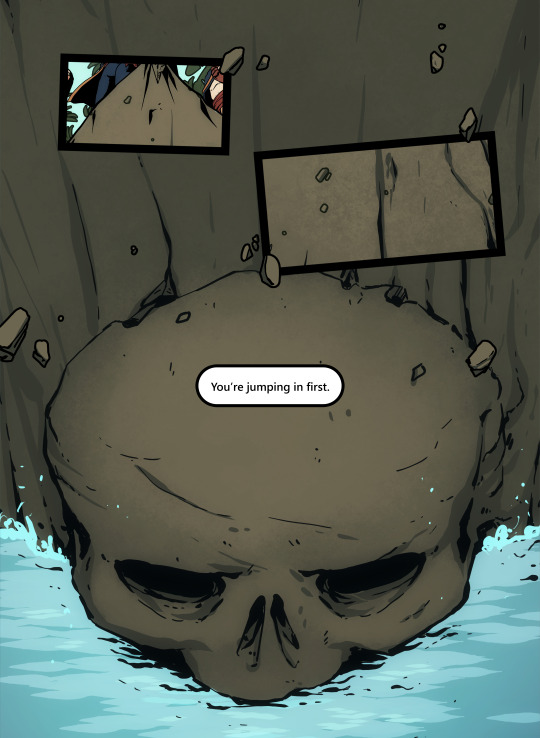
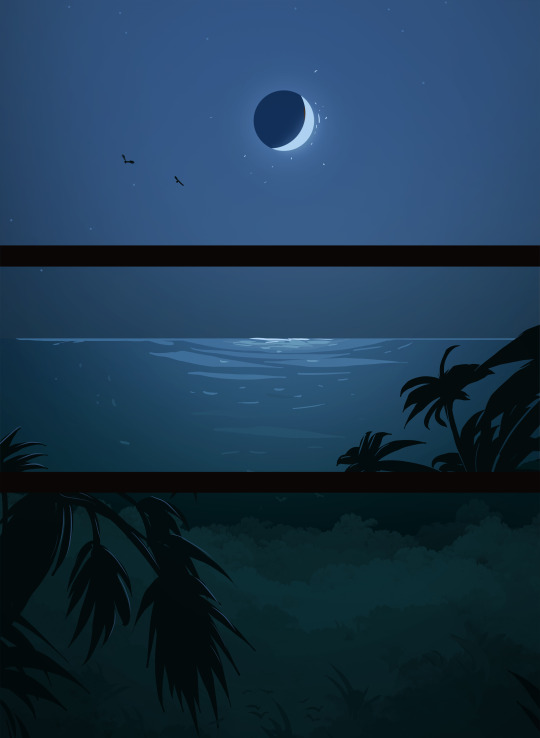
Another issue when converting pages is that panel order is a lot less straightforward than when starting from print format. Conversational back and forth that's fine in scroll often messes up the flow of reading in a page (characters facing out, not looking at eachother from panel to panel, etc) and so some creative solutions are necessary to keeping the reading order.
For the first page I had to delete and rearrange some panels, and in the second the dialogue bubbles guide us to read this page in a circle. (dialogue guides through a lot of my pages lol)
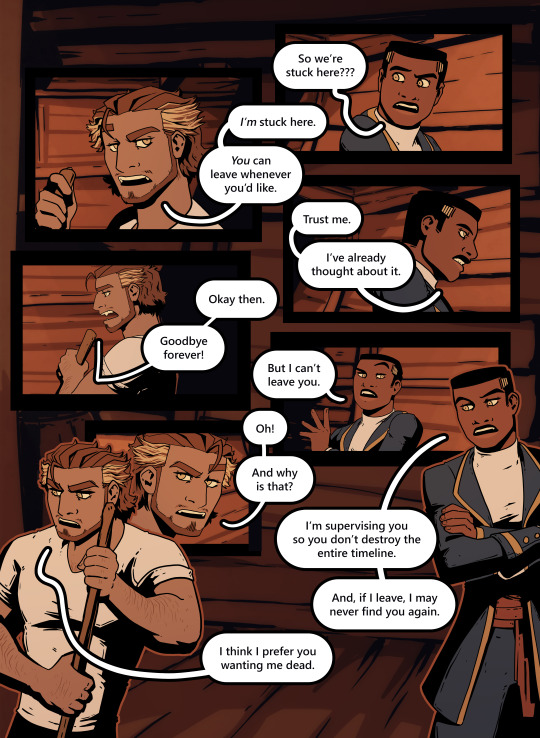
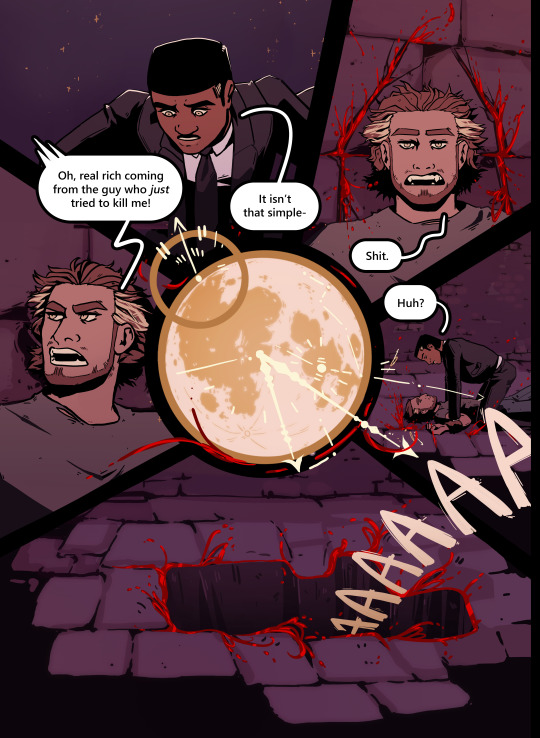
And the last really common issue that pops up is that height differences can be really difficult. Usually in print this is solved with clever angles, but I’ve already drawn everything. So, I’ll either resort to vertical shaped panels, panel pop-outs, or editing a character up or down to fit into the panel.
(examples in order)
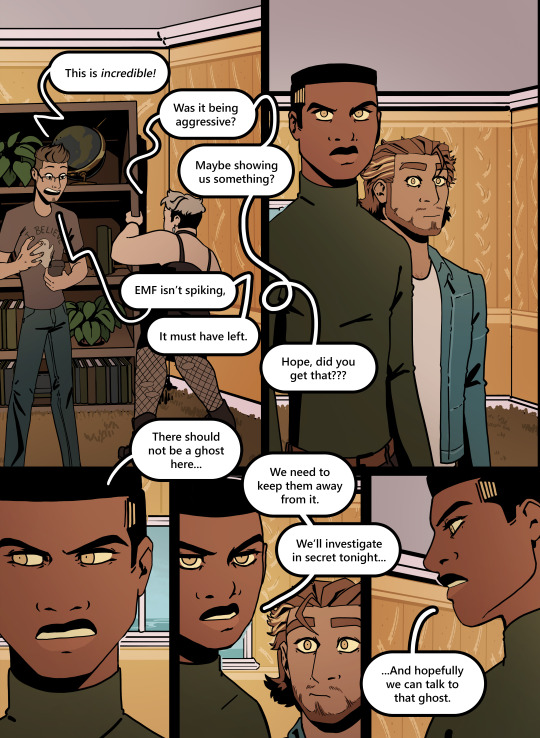

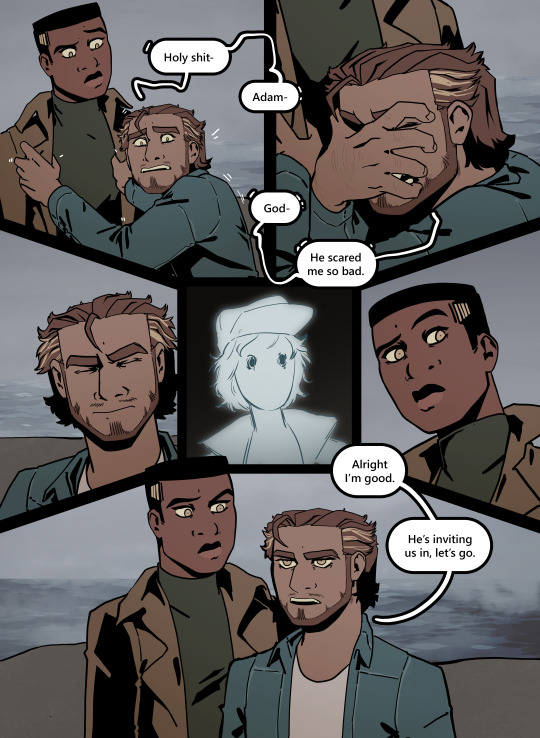
So, yes, it is difficult! But I have a lot of experience with both formats, and having prepared for this from the beginning I've been able to make the transition a LOT more smoothly than I otherwise could have.
I hope this helps!
And, thank you about the kickstarter! I'm extremely excited I'll be able to print these, the proofs I've received so far look just absolutely stunning and I'm so so so excited to get to send them to people!!!
Obligatory self promo, if you want to see the kickstarter page and get these four books for yourself, then you can check it out here ^^ It's been funded, so at this point we're just reaching stretch goals and placing orders!
#asks#anon#art tips#comic tips#web comics#comic books#comic advice#also this is just my own experience obviously everyone works differently and I cant promise this will work for you too#but doing things this way I've been able to finish about an episode (15 pages or so) every day#so it's been extremely swift (though also of course a ton of work)#thank you past me for making this so easy!!!#it'd easily take 5x as long without the prep I did!!!
184 notes
·
View notes
Note
indie do you have any tips on comic making? (coming from someone who's trying to make their own tmnt comic)
Sure! I can try my best!
Plan your story beginning to end! It doesn’t have to be a movie script but just something that keeps track of the plot, its twists, characters and their motivations and stuff. ROTP’s plot was almost entirely written on a week to week basis. The only chapters that were planned out were 1, 2, 8, 9, and 10. It seems counterintuitive, but it’s not fun to write a comic shoot-from-the-hip that way. You’re more prone to writer’s block and thus giving up entirely. Do yourself a favor and write the story ahead of time!
Establish a style! You want something that when people scroll through social media go “Hey! I know that style!” I unfortunately can’t give you many tips on this, but I’ve had people tell me that the way I the way I draw faces is very unique. If you don’t feel like you have a style, just try a ton of different stuff until something clicks with you! Adopting techniques from other styles is okay too!
Go at your own pace! Pacing your progress to your own life and speed is very important, especially for avoiding burnout! For me, I have enough time to do 5 pages a week, but maybe you need more time, or maybe you need less, or maybe you wanna do more pages or fewer, it’s all up to you and how you’re life functions! Whatever you choose though, I highly recommend setting it to a schedule if you can. When people discover your comic and really like it, they’re gonna want to know when to come back for more; repeat costumers, if that makes sense. Eventually that predictably will make your comic grow!
Sorry, that was a bit long, but yeah, there’s 3 tips, most of which I learned from experience. Hopefully you found these helpful, and I wish you luck in comic making!
Good question! :]
77 notes
·
View notes
Note
When you make a comic how do you make one as a beginner like is there a way that I have to do it or do I just do it normally how I draw (I just need some help with it because I'm making a comic series 🥲)
I'll try my best to explain it here (I'll have some videos hyperlinked at the end)
Drawing comics as a beginner definitely takes a lot of time, and there's a lot to think of when it comes down to making one. It's very easy to say "just do it," and in most cases, it really is just jumping in and just doing it.
What I will say is, if it's a series that has an end goal in mind, it's always good to figure out the story first and plot an outline on what's going to happen. If there isn't, and it's more of a slice of life/no overarching plot, don't worry about too much scripting or planning (and just have fun with it).
Writing a script also helps so you can plan what the characters are saying/doing.
Some examples of how i usually script (Freaky Friday and another original comic project I have planned)

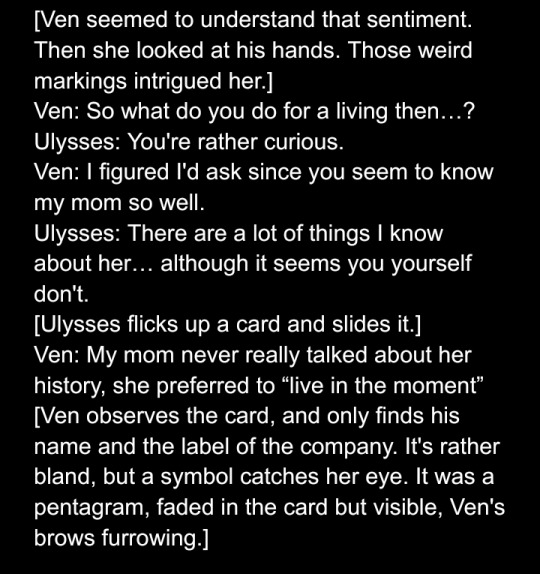
(Doesn't have to look like mine, but it helps you get a visual for what you want said/done)
I found that making comics is that I kinda just learned as I went along, even if I wasn't 100% good with drawing certain things like perspective or backgrounds. You'll be forced to draw things you dont like or aren't good at, but with practice, you'll get there.
There isn't a specific way to make a comic at all since everyone's work flows are different, or they change based on what they need.
My usual workflow is basically:
Story plotting > writing > storyboarding/sketching > drawing > coloring > final rendering (optional/depends on style)
You might have a different drawing process, and that's fine. As long as you're comfortable with how you do your work, there wouldn't be much of a reason to change it. If it's causing frustration, it's always good to switch it up to find what suits you.
My advice is to just try to find a workflow that fits you best and see how long it takes to do a certain number of pages, like 5 pages within 5 hrs as an example. I watched a lot of YouTube videos on tips
Here's a pretty short playlist to introduce beginners to comic making tips
#also be sure to take breaks#(<- needs to take my own advice)#art advice#(i hope it helped)#ven speaks#comic tips#ask
33 notes
·
View notes
Text
youtube
Not exactly writing, but an art tip for my webcomic creator followers :)
#webcomic#indie comic#comic#comic advice#comic tips#art advice#art tips#rightwriter#youtube#manu mercurial#Youtube
51 notes
·
View notes
Text
My one art/comic tip is don’t cross speech bubble tails, it can make your comic awkward to read and generally looks messy.
If the comic is simple and doesn’t require specific character placement, just flip the image. You might have to fix your character’s asymmetrical design.
Or stack the speech bubbles so the tails can point wherever freely
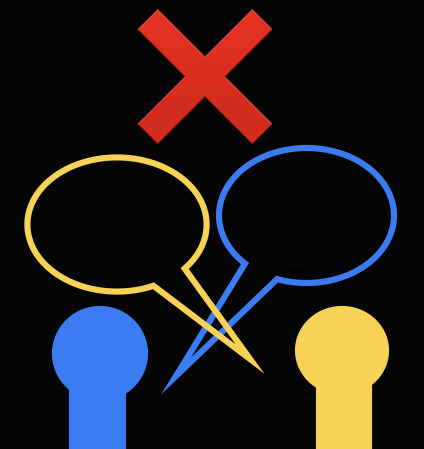



#i don’t want to do a bunch of corny art hacks and DO’S AND DON’TS tutorials but this is an easy fix#i hate figuring out composition too but this irks me. I’m sure I’m not alone here#rules can be bent/broken for effect but I see this way too often#art tips#artist tips#comic tips#composition
15 notes
·
View notes
Note
Hi Pix!! How are doing? I wanted to ask.... Is there any advice you could give me about writting a comic? I want to make a comic but I just don't know how to start writting it and it's driving me crazy... I hope you're having a nice day!
Hi hello! I can share some tips of my whole drawing process hopefully that helps ;w;)b
So I guess I start by writing down any idea I have and then I write the dialogue down on my notes

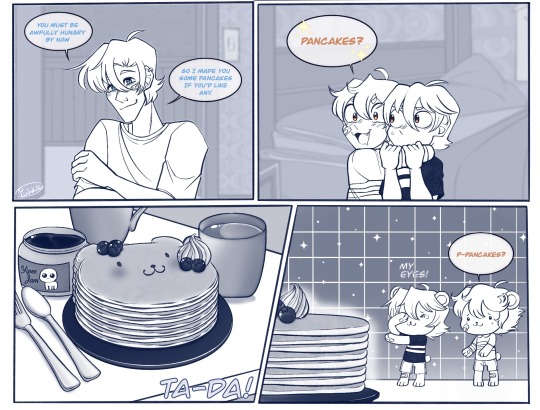
I don’t always keep the dialogue the same tho because once you start drawing it out you want to add or take away stuff then maybe also make some jokes or change the expressions or reactions so sometimes the dialogue is just a sort of base to help you start drawing something and keep the ball rolling y’know?
This is also not necessary but sometimes making a drawing or speech bubble pop out of a panel just makes it more fun >>
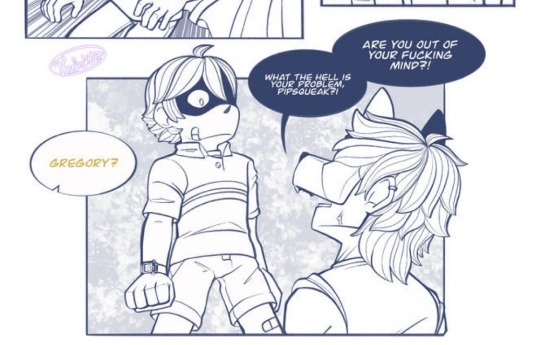
Also might help with perspective a little make it more pleasing to the eyes I think ;w;
And tbh? Just using lots of references? maybe saving cartoon or manga panels or even screenshots of a show you like to use to redraw for practice or give you an idea of what to draw helps a ton ฅ(≚ᄌ≚) even some other artists might give you an idea of what to do >> tbh I learned to use gradient or patterns in backgrounds from artists I follow here and some sonic comics like IDW or Steven universe 👌 so yeah ;v; have fun, stay hydrated and save those refs 💖 goodluck with your comic, I’m sure it will turn out amazing 💖💖💖
70 notes
·
View notes